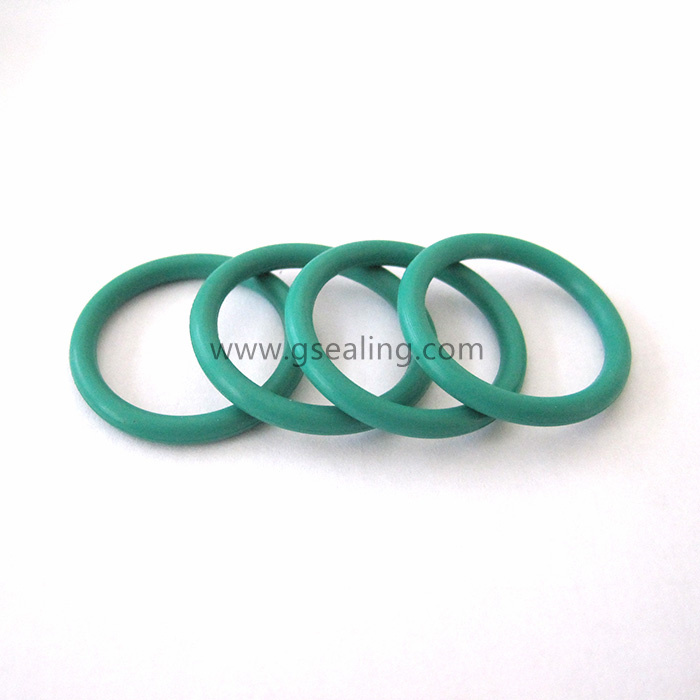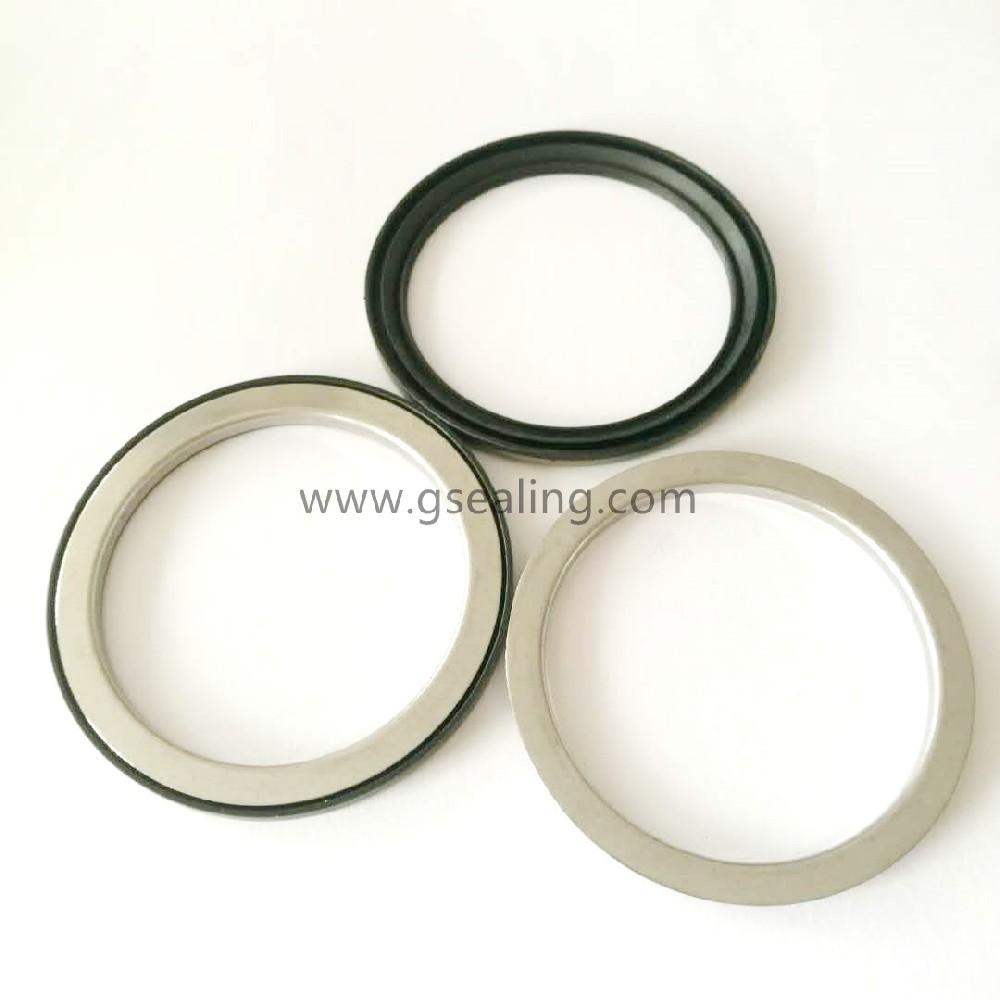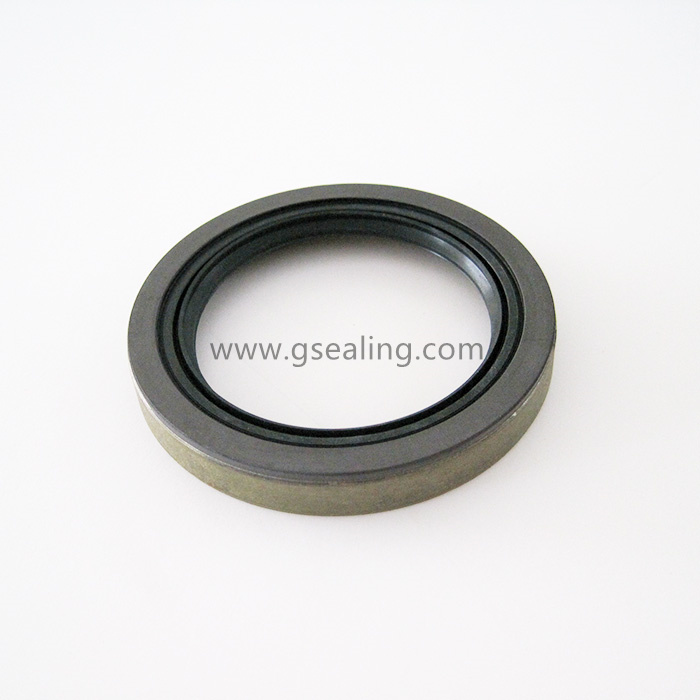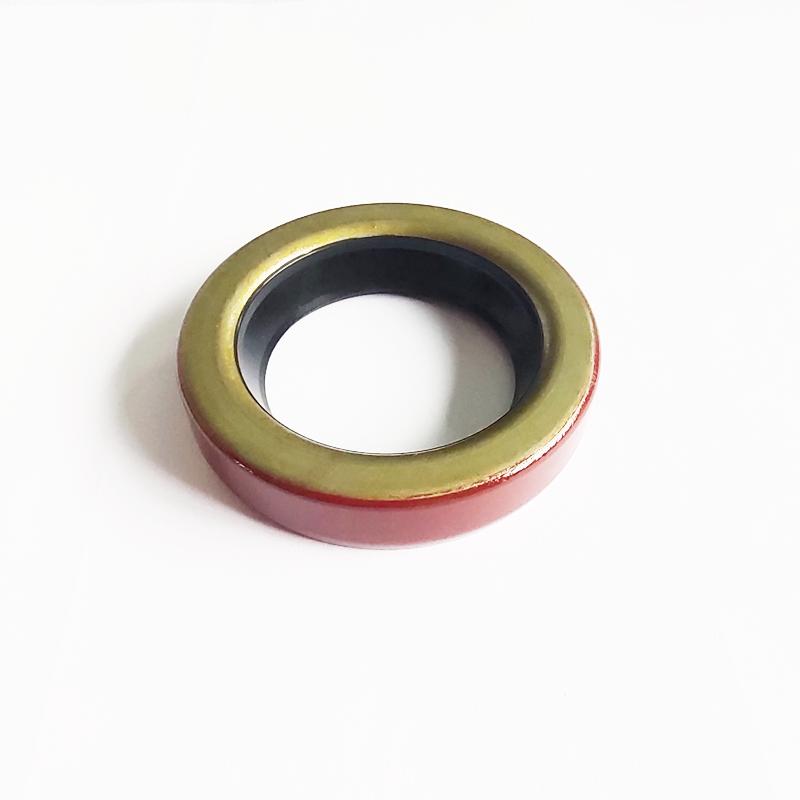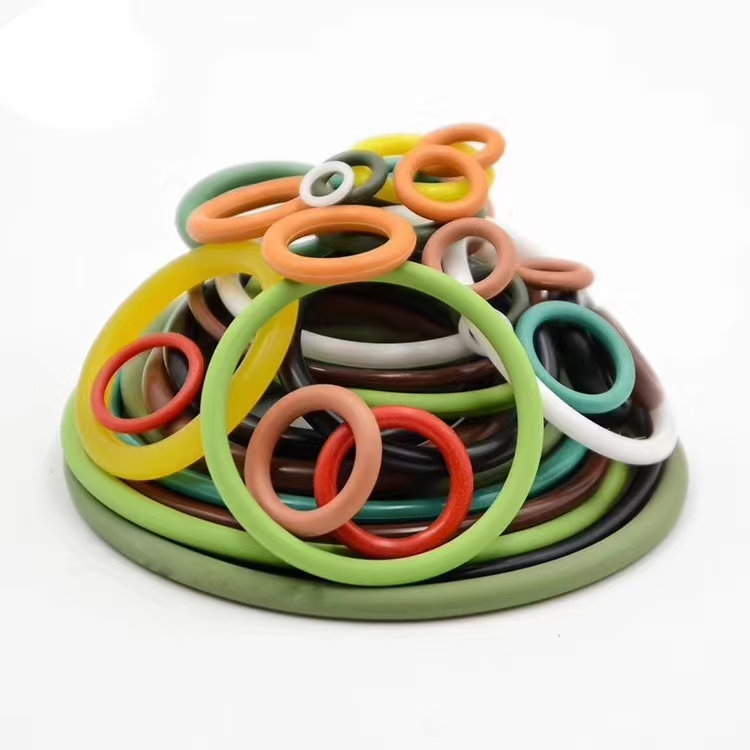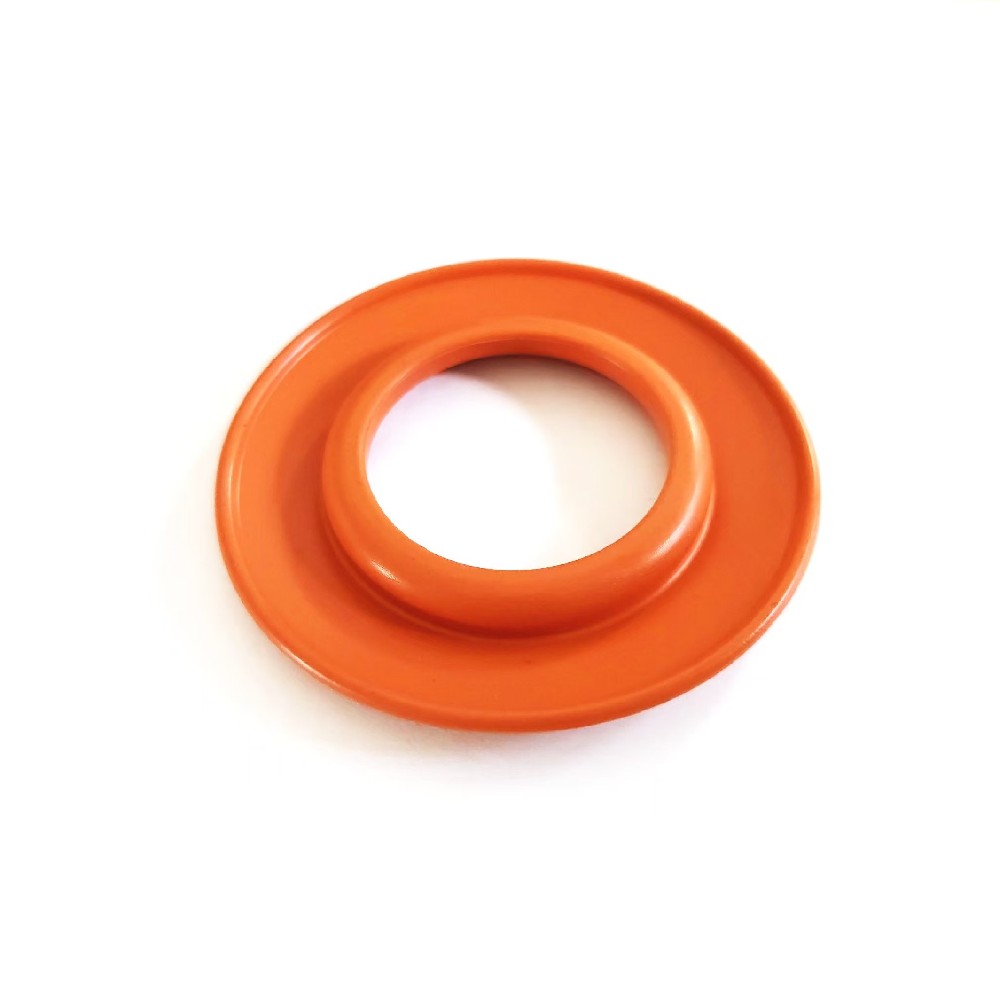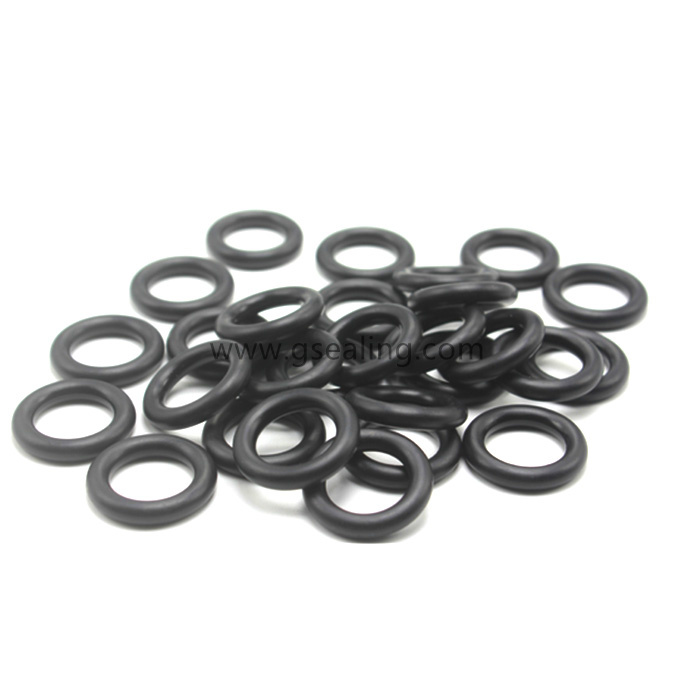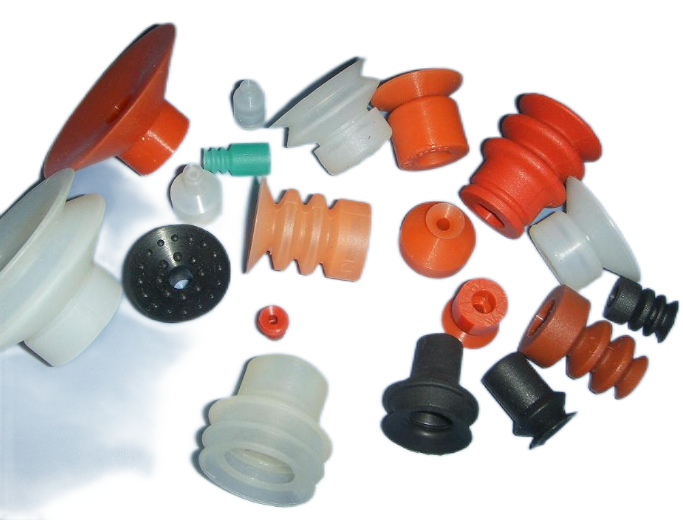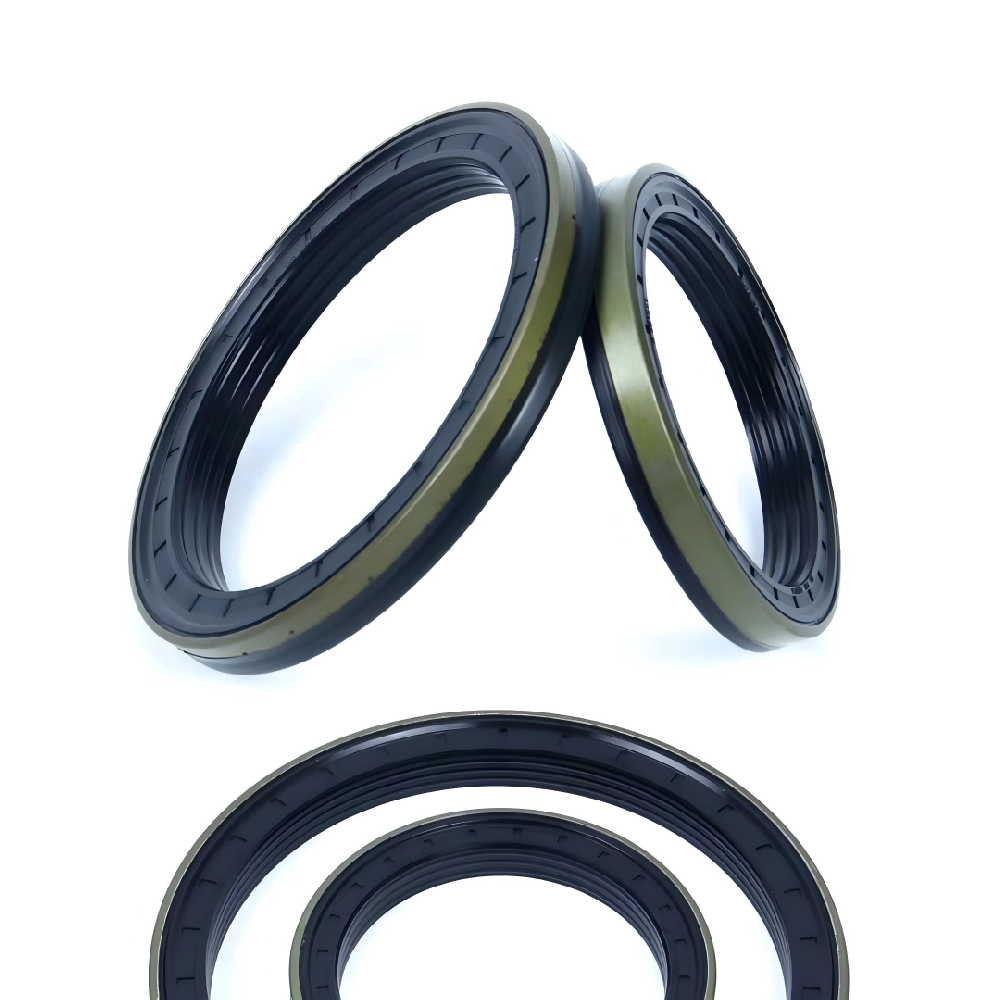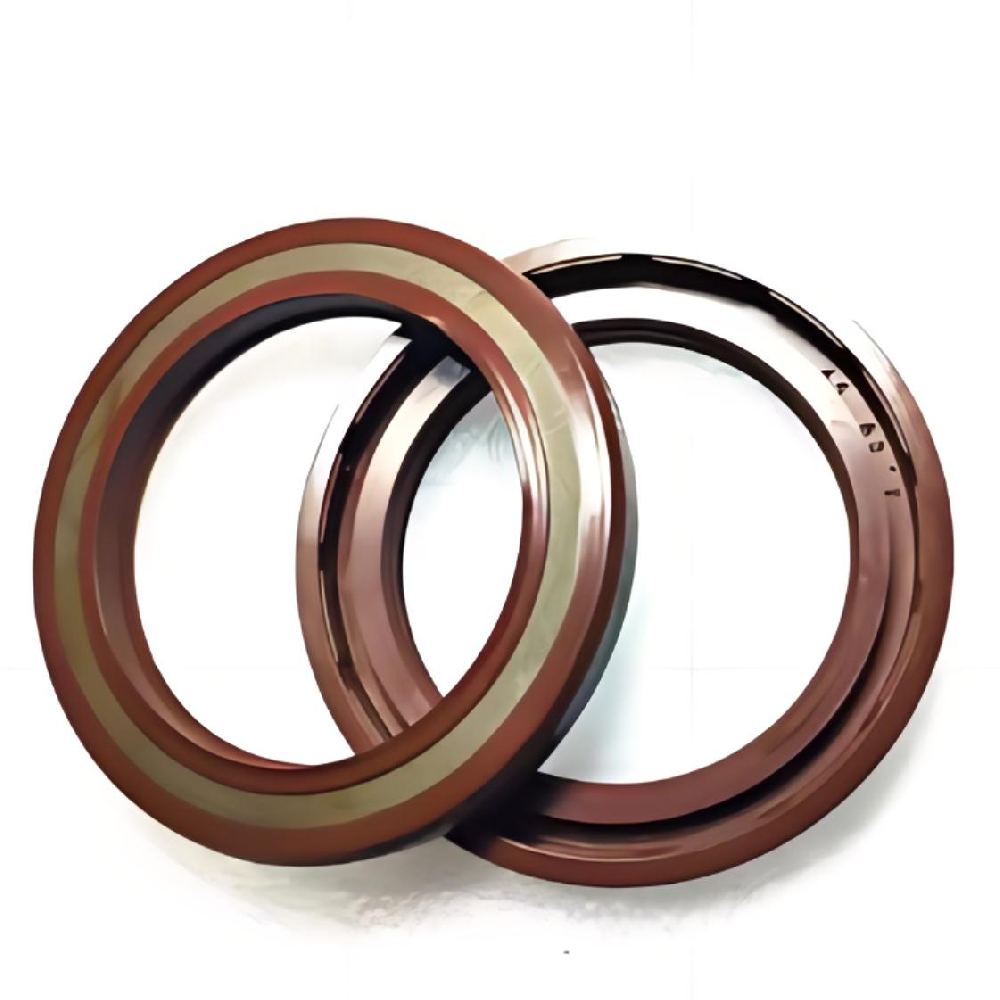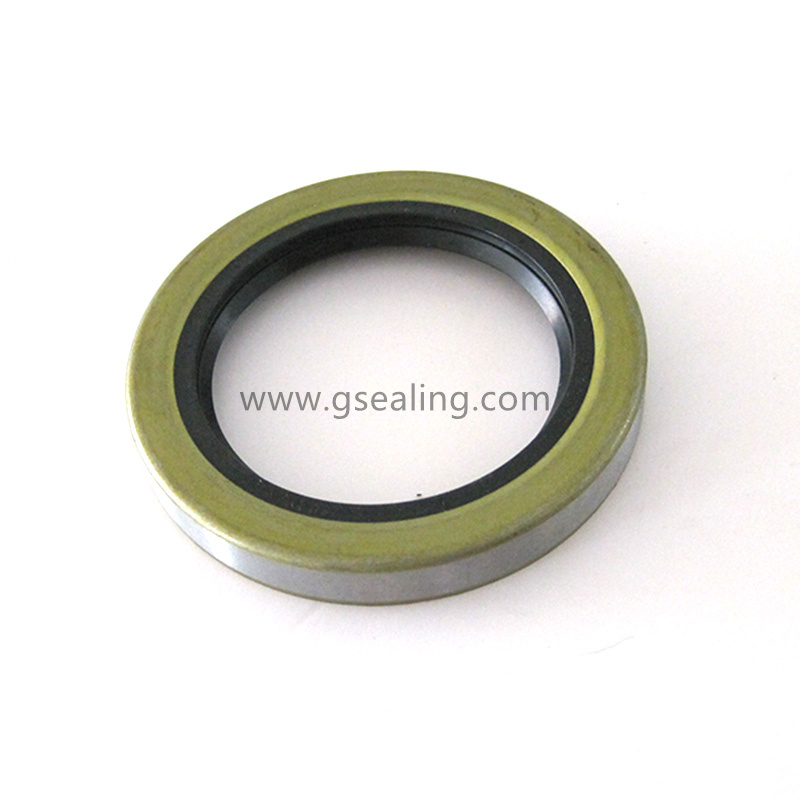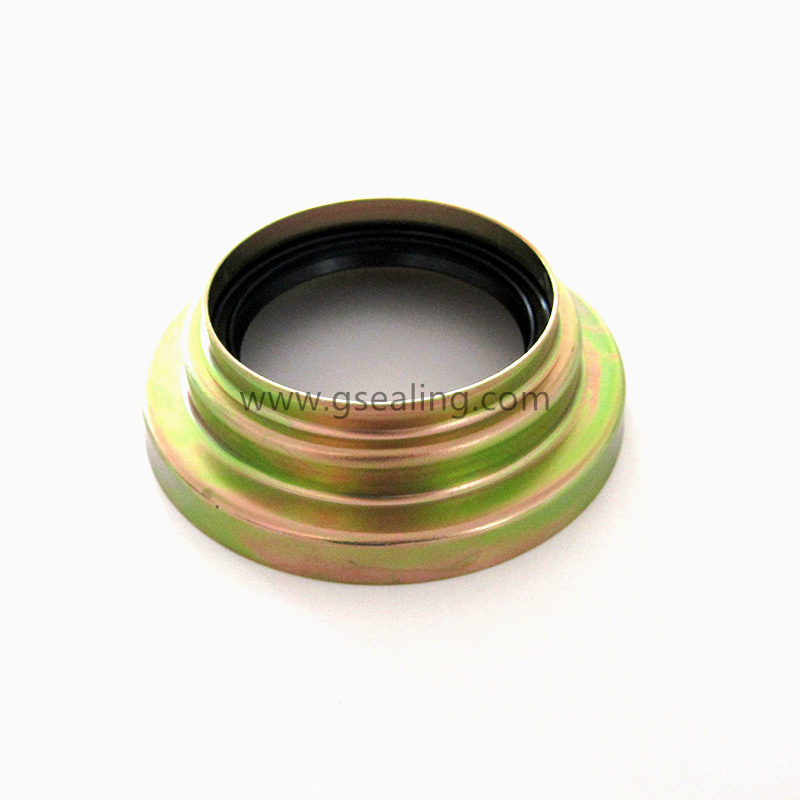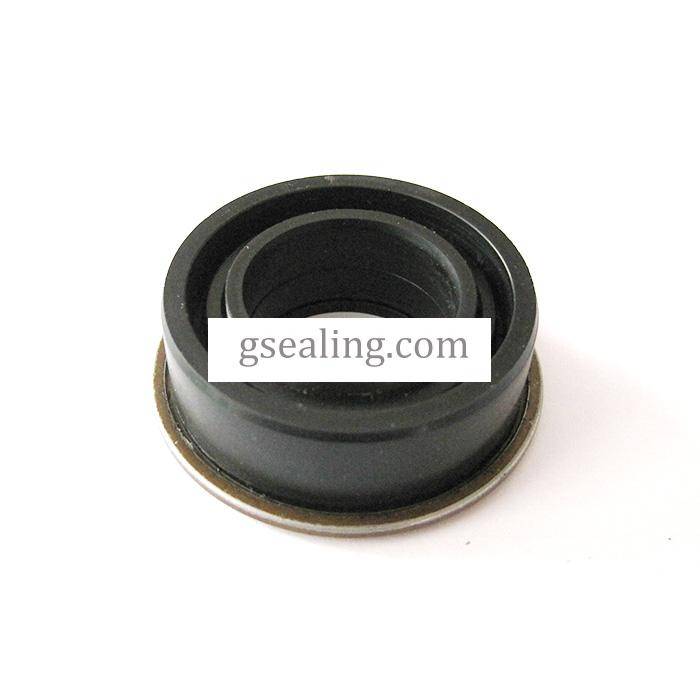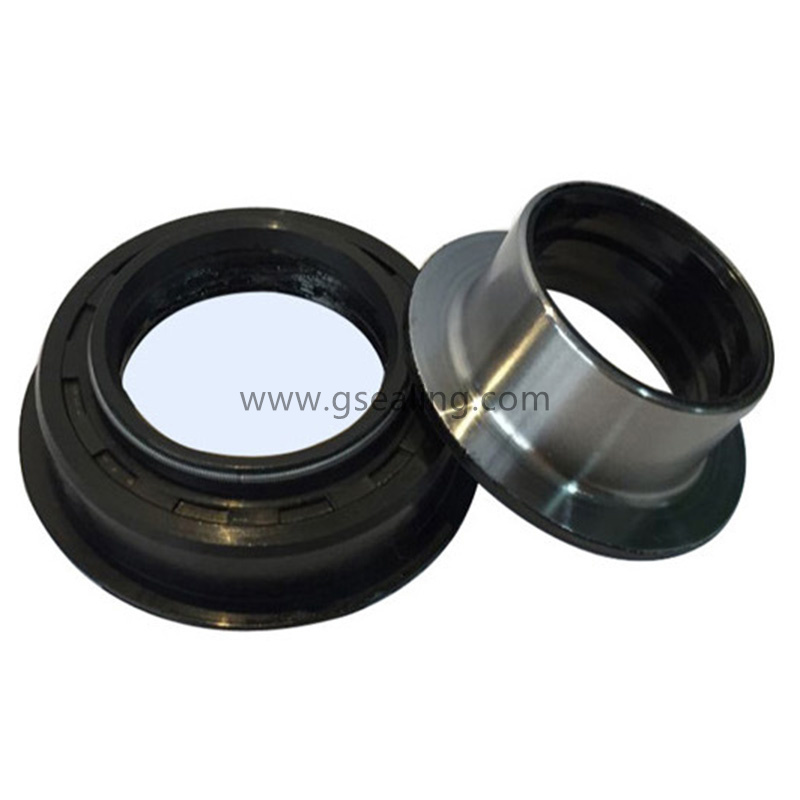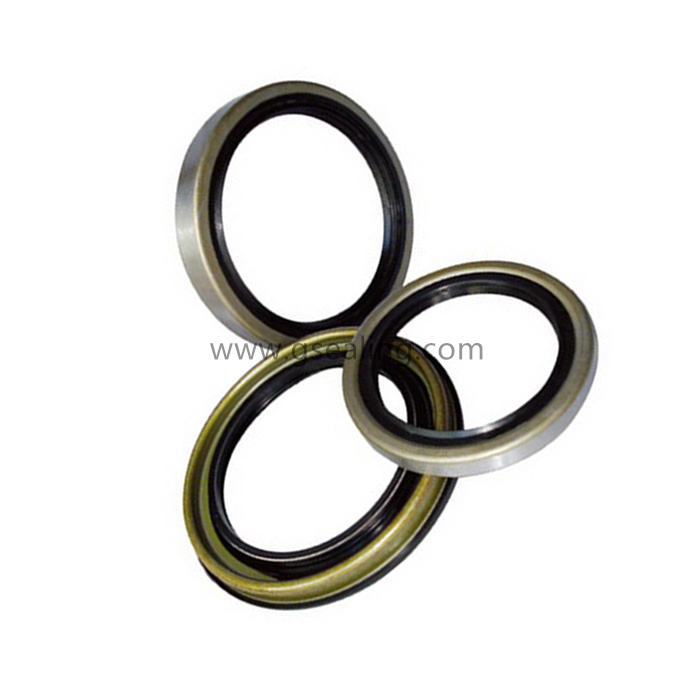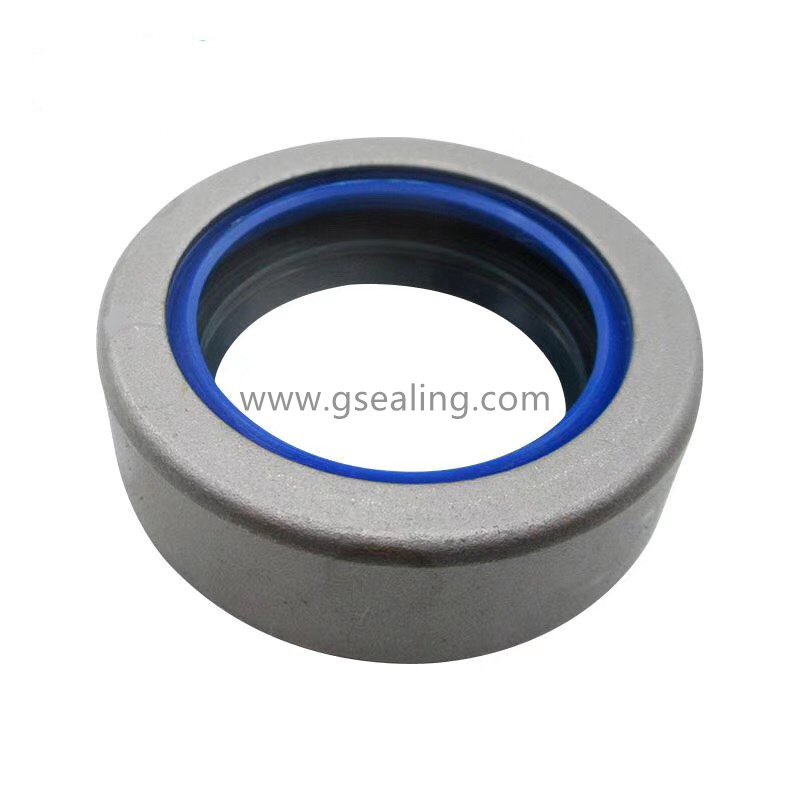Recommended Products
What factors influence the performance of industry rubber seals
The sealing effect of the sealing ring is related to the material characteristics of the sealing ring. There is also a close influence on other factors. For example, the speed of rotation, working temperature, working pressure, working medium, etc., today I will tell you about the four factors that affect the sealing performance of the sealing ring.
First, the speed of rotation
When the rotation speed is very low (< 0.03m/s), it is necessary to consider the smoothness of the operation of the equipment and whether the operational appears "crawling" phenomenon. When the movement speed is very high (> 0.8m/s), the lubricating oil film may be destroyed, and the oil seal is not well lubricated and frictions heat, resulting in greatly reduced life. It is recommended that polyurethane or rubber and plastic oil seal work in the speed range of 0.03m/s ~ 0.8m/s. High-speed oil seals need to put forward higher requirements for structure and material, and the speed of household appliances oil seals can reach 20000rpm. Both wear and temperature resistance need to be met, and the concentricity requirements of dynamic sealing on the installation are relatively high.
Second, the temperature of the working environment
Low temperature will reduce the elasticity of rubber and plastic oil seals, resulting in leakage, and even the entire oil seal becomes hard and brittle. High temperature will make the oil seal volume expansion, soft, resulting in the oil seal friction resistance increases rapidly and the pressure resistance decreases. It is recommended that the continuous operating temperature range of ordinary polyurethane or rubber and plastic oil seals be -10 ° C to +80 ° C. For the high temperature and high speed requirements of the working environment, we need to choose to use fluorine rubber and PTFE, high temperature resistance and wear resistance is better, the low temperature environment is generally to -40 degrees, and the rubber performance is tested at high and low temperatures to ensure that the product quality meets the requirements.
Third, the working pressure of machinery
The oil seal has a minimum service pressure requirement. Oil seals with low friction and low starting resistance should be selected for low pressure work. Below 2.5MPa, polyurethane oil seal is not suitable; High pressure to consider the oil seal pressure deformation, need to use anti-extrusion stop ring, grooving processing also has special requirements.
Fourth, the working medium
General sealing media are gasoline, oil, diesel, grease, and some static sealing dust. In addition to selecting the working medium strictly according to the manufacturer's recommendations, it is important to keep the working medium clean. Aging or contamination of the oil will not only cause the components in the system to fail, accelerate the aging and friction of the oil seal, but also the dirt in it may scratch or embed the oil seal, making the seal fail. Therefore, it is necessary to regularly check the quality of the oil and its cleanliness, and replace the oil filter or oil according to the maintenance specifications of the equipment. The air remaining in the oil in the cylinder will be compressed by high pressure, which will cause the oil seal to burn out or even carbonize. In order to avoid this situation, exhaust treatment should be carried out at the initial operation of the hydraulic system. The hydraulic cylinder should also run at low pressure and slow speed for a few minutes to confirm that the residual air in the oil has been drained before it can work normally.
|
Type |
Pitch(pb) |
Tooth height(ht) |
Belt thickness(hs) |
Angle β° |
Detail |
|
MXL |
2.032 |
0.51 |
1.14 |
40 |
|
|
XL |
5.080 |
1.27 |
2.30 |
50 |
|
|
XXL |
3.175 |
0.76 |
1.52 |
50 |
|
|
L |
9.525 |
1.91 |
3.60 |
40 |
|
|
H |
12.7 |
2.29 |
4.30 |
40 |
|
|
XH |
22.225 |
6.35 |
11.20 |
40 |
|
|
XXH |
31.750 |
9.53 |
15.70 |
40 |
Detail |
|
T2.5 |
2.5 |
0.7 |
1.30 |
40 |
|
|
T5 |
5 |
1.20 |
2.20 |
40 |
|
|
T10 |
10 |
2.50 |
4.50 |
40 |
|
|
T20 |
20 |
5.00 |
8.00 |
40 |
Detail |
|
AT5 |
5 |
1.20 |
2.70 |
50 |
Detail |
|
AT10 |
10 |
2.5. |
5.00 |
50 |
Detail |
|
AT20 |
20 |
5.00 |
8.00 |
50 |
Detail |


In stallation size is available if need.

|
Specification |
Section line length |
Tooth number |
Specification |
Section line length |
Tooth number |
Specification |
Section line length |
Tooth number |
|
B40MXL* |
81.28 |
40 |
B93MXL* |
188.98 |
93 |
B145MXL* |
294.64 |
145 |
|
B41MXL* |
83.31 |
41 |
B94MXL* |
191.01 |
94 |
B147MXL* |
298.70 |
147 |
|
B42MXL* |
85.34 |
42 |
B95MXL* |
193.04 |
95 |
B148MXL* |
300.74 |
148 |
|
B43MXL* |
87.38 |
43 |
B96MXL* |
195.07 |
96 |
B149MXL* |
302.77 |
149 |
|
B45MXL* |
91.44 |
45 |
B97MXL* |
197.10 |
97 |
B150MXL* |
304.80 |
150 |
|
B48MXL* |
97.54 |
48 |
B98MXL* |
199.14 |
98 |
B151MXL* |
306.83 |
151 |
|
B49MXL* |
99.57 |
49 |
B100MXL* |
203.20 |
100 |
B152MXL* |
308.86 |
152 |
|
B50MXL* |
101.60 |
50 |
B101MXL* |
206.23 |
101 |
B155MXL* |
314.96 |
155 |
|
B52MXL* |
105.66 |
52 |
B102MXL* |
207 26 |
102 |
B156MXL* |
316.99 |
156 |
|
B53MXL* |
107.70 |
53 |
B103MXL* |
209 30 |
103 |
B157MXL* |
319.02 |
157 |
|
B54MXL* |
109.73 |
54 |
B104MXL* |
211.33 |
104 |
B158MXL* |
321.06 |
158 |
|
B55MXL* |
111.76 |
55 |
B105MXL* |
213.36 |
105 |
B159MXL* |
323.09 |
159 |
|
B56MXL* |
113.79 |
56 |
B106MXL* |
215.39 |
106 |
B160MXL* |
325.12 |
160 |
|
B57MXL* |
115.82 |
57 |
B107MXL* |
217.42 |
107 |
B162MXL* |
329.18 |
162 |
|
B58MXL* |
117.86 |
58 |
B108MXL* |
219.46 |
108 |
B163MXL* |
331.22 |
163 |
|
B59MXL* |
119.89 |
59 |
B109MXL* |
221.49 |
109 |
B164MXL* |
333.25 |
164 |
|
B60MXL* |
121.92 |
60 |
B110MXL* |
223.52 |
110 |
B165MXL* |
335.28 |
165 |
|
B61MXL* |
123.95 |
61 |
B111MXL* |
225.55 |
111 |
B166MXL* |
337.31 |
166 |
|
B62MXL* |
125.98 |
62 |
B112MXL* |
227.58 |
112 |
B168MXL* |
341.38 |
168 |
|
B63MXL* |
128.02 |
63 |
B113MXL* |
229.62 |
113 |
B170MXL* |
345.44 |
170 |
|
B64MXL* |
130.05 |
64 |
B114MXL* |
231.65 |
114 |
B171MXL* |
347.47 |
171 |
|
B65MXL* |
132.08 |
65 |
B115MXL* |
233.68 |
115 |
B175MXL* |
355.60 |
175 |
|
B66MXL* |
134.11 |
66 |
B116MXL* |
235.71 |
116 |
B177MXL* |
359.66 |
177 |
|
B67MXL* |
136.14 |
67 |
B118MXL* |
239.78 |
118 |
B180MXL* |
365.76 |
180 |
|
B68MXL* |
138.18 |
68 |
B119MXL* |
241.81 |
119 |
B183MXL* |
371.86 |
183 |
|
B69MXL* |
140.21 |
69 |
B120MXL* |
243.84 |
120 |
B184MXL* |
373.89 |
184 |
|
B70MXL* |
142.24 |
70 |
B121MXL* |
245.87 |
121 |
B187MXL* |
379.98 |
187 |
|
B71MXL* |
144.27 |
71 |
B122MXL* |
247.90 |
122 |
B188MXL* |
382.02 |
188 |
|
B72MXL* |
146.30 |
72 |
B123MXL* |
249.94 |
123 |
B190MXL* |
386.08 |
190 |
|
B73MXL* |
148.34 |
73 |
B124MXL* |
251.97 |
124 |
B194MXL* |
394.21 |
194 |
|
B74MXL* |
150.37 |
74 |
B125MXL* |
254.00 |
125 |
B195MXL* |
396.24 |
195 |
|
B75MXL* |
152.40 |
75 |
B126MXL* |
256.03 |
126 |
B198MXL* |
402.34 |
198 |
|
B76MXL* |
154.43 |
76 |
B127MXL* |
258.06 |
127 |
B200MXL* |
406.40 |
200 |
|
B77MXL* |
156.46 |
77 |
B128MXL* |
260.10 |
128 |
B202MXL* |
410.40 |
202 |
|
B78MXL* |
158.50 |
78 |
B129MXL* |
262.13 |
129 |
B203MXL* |
412.50 |
203 |
|
B79MXL* |
160.53 |
79 |
B130MXL* |
264.16 |
130 |
B208MXL* |
422.66 |
208 |
|
B80MXL* |
162.56 |
80 |
B131MXL* |
266.19 |
131 |
B210MXL* |
426.72 |
210 |
|
B82MXL* |
164.59 |
82 |
B132MXL* |
268.22 |
132 |
B212MXL* |
430.78 |
212 |
|
B83MXL* |
168.66 |
83 |
B133MXL* |
270.26 |
133 |
B215MXL* |
436.88 |
215 |
|
B84MXL* |
170.69 |
84 |
B134MXL* |
272.29 |
134 |
B216MXL* |
438.91 |
216 |
|
B85MXL* |
172.72 |
85 |
B135MXL* |
274.32 |
135 |
B221MXL* |
449.07 |
221 |
|
B86MXL* |
174.75 |
86 |
B136MXL* |
276.35 |
136 |
B222MXL* |
451.10 |
222 |
|
B87MXL* |
176.78 |
87 |
B138MXL* |
280.42 |
138 |
B227MXL* |
461.26 |
227 |
|
B88MXL* |
178.82 |
88 |
B139MXL* |
282.45 |
139 |
B228MXL* |
463.30 |
228 |
|
B89MXL* |
180.85 |
89 |
B140MXL* |
284.48 |
140 |
B229MXL* |
465.33 |
229 |
|
B90MXL* |
182.88 |
90 |
B142MXL* |
288.54 |
142 |
B230MXL* |
467.36 |
230 |
|
B91MXL* |
184.91 |
91 |
B143MXL* |
290.58 |
143 |
B232MXL* |
471.42 |
232 |
|
B92MXL* |
186.94 |
92 |
B144MXL* |
292.61 |
144 |
|
|
|
|
Specification |
Section line length |
Tooth number |
Specification |
Section line length |
Tooth number |
Specification |
Section line length |
Tooth number |
|
B236MXL* |
479.55 |
236 |
B408MXL* |
829.06 |
408 |
B1078MXL* |
2190.50 |
1078 |
|
B237MXL* |
481.58 |
237 |
B412MXL* |
837.18 |
412 |
B1080MXL* |
2194.56 |
1080 |
|
B238MXL* |
483.62 |
238 |
B424MXL* |
861.57 |
424 |
B1082MXL* |
2198.62 |
1082 |
|
B239MXL* |
485.65 |
239 |
B427MXL* |
867.66 |
427 |
B1090MXL* |
2214.88 |
1090 |
|
B240MXL* |
487.68 |
240 |
B434MXL* |
881.89 |
434 |
B1092MXL* |
2218.94 |
1092 |
|
B243MXL* |
493.78 |
243 |
B453MXL* |
920.50 |
453 |
B1098MXL* |
2231.14 |
1098 |
|
B245MXL* |
497.84 |
245 |
B460MXL* |
934.72 |
460 |
B1100MXL* |
2235.20 |
1100 |
|
B248MXL* |
503.94 |
248 |
B463MXL* |
940.82 |
463 |
B1166MXL* |
2369.31 |
1166 |
|
B250MXL* |
508.00 |
250 |
B464MXL* |
942.85 |
464 |
B1200MXL* |
2438.40 |
1200 |
|
B251MXL* |
510.03 |
251 |
B468MXL* |
950.98 |
468 |
B1300MXL* |
2641.60 |
1300 |
|
B255MXL* |
518.16 |
255 |
B472MXL* |
959.10 |
472 |
B1350MXL* |
2743.20 |
1350 |
|
B256MXL* |
520.19 |
256 |
B475MXL* |
965.20 |
475 |
B1380MXL* |
2804.16 |
1380 |
|
B263MXL* |
534.42 |
263 |
B478MXL* |
971.30 |
478 |
B1392MXL* |
2828.54 |
1392 |
|
B265MXL* |
538.48 |
265 |
B482MXL* |
979.42 |
482 |
B1400MXL* |
2844.80 |
1400 |
|
B270MXL* |
548.64 |
270 |
B487MXL* |
989.58 |
487 |
B1430MXL* |
2905.76 |
1430 |
|
B276MXL* |
560.83 |
276 |
B505MXL* |
1026.16 |
505 |
B1450MXL* |
2946.40 |
1450 |
|
B280MXL* |
568.96 |
280 |
B531MXL* |
1078.99 |
531 |
B1470MXL* |
2987.04 |
1470 |
|
B283MXL* |
575.06 |
283 |
B540MXL* |
1097.28 |
540 |
B1490MXL* |
3027.68 |
1490 |
|
B285MXL* |
579.12 |
285 |
B541MXL* |
1099.31 |
541 |
B1500MXL* |
3048.00 |
1500 |
|
B290MXL* |
589.28 |
290 |
B544MXL* |
1105.41 |
544 |
B1520MXL* |
3088.64 |
1520 |
|
B292MXL* |
593.34 |
292 |
B546MXL* |
1109.47 |
546 |
B1530MXL* |
3108.96 |
1530 |
|
B295MXL* |
599.44 |
295 |
B549MXL* |
1115.57 |
549 |
B1550MXL* |
3149.60 |
1550 |
|
B297MXL* |
603.50 |
297 |
B550MXL* |
1117.60 |
550 |
B1560MXL* |
3169.92 |
1560 |
|
B298MXL* |
605.54 |
298 |
B556MXL* |
1129.79 |
556 |
B1580MXL* |
3210.56 |
1580 |
|
B300MXL* |
609.60 |
300 |
B557MXL* |
1131.82 |
557 |
B1620MXL* |
3291.84 |
1620 |
|
B305MXL* |
619.76 |
305 |
B558MXL* |
1133.86 |
558 |
B1650MXL* |
3352.80 |
1650 |
|
B309MXL* |
627.89 |
309 |
B559MXL* |
1135.89 |
559 |
B1670MXL* |
3393.44 |
1670 |
|
B310MXL* |
629.92 |
310 |
B562MXL* |
1141.98 |
562 |
B1690MXL* |
3434.08 |
1690 |
|
B315MXL* |
640.08 |
315 |
B563MXL* |
1144.02 |
563 |
B1710MXL* |
3474.72 |
1710 |
|
B320MXL* |
650.24 |
320 |
B566MXL* |
1150.11 |
566 |
B1730MXL* |
3515.36 |
1730 |
|
B323MXL* |
656.34 |
323 |
B568MXL* |
1154.18 |
568 |
B1750MXL* |
3556.00 |
1750 |
|
B324MXL* |
658.37 |
324 |
B570MXL* |
1158.24 |
570 |
B1770MXL* |
3596.64 |
1770 |
|
B328MXL* |
666.50 |
328 |
B573MXL* |
1164.34 |
573 |
B1778MXL* |
3612.90 |
1778 |
|
B330MXL* |
670.56 |
330 |
B578MXL* |
1174.50 |
578 |
B1800MXL* |
3657.60 |
1800 |
|
B334MXL* |
678.69 |
334 |
B580MXL* |
1178.56 |
580 |
B1806MXL* |
3669.79 |
1806 |
|
B340MXL* |
690.88 |
340 |
B583MXL* |
1184.66 |
583 |
B1900MXL* |
3860.80 |
1900 |
|
B347MXL* |
705.10 |
347 |
B592MXL* |
1202.94 |
592 |
B2000MXL* |
4064.00 |
2000 |
|
B350MXL* |
711.20 |
350 |
B605MXL* |
1229.36 |
605 |
B2044MXL* |
4153.41 |
2044 |
|
B358MXL* |
727.46 |
358 |
B612MXL* |
1243.58 |
612 |
B2100MXL* |
4267.20 |
2100 |
|
B360MXL* |
731.52 |
360 |
B648MXL* |
1316.74 |
648 |
B2200MXL* |
4470.40 |
2200 |
|
B363MXL* |
727.46 |
363 |
B652MXL* |
1324.86 |
652 |
B2300MXL* |
4673.60 |
2300 |
|
B365MXL* |
737.62 |
365 |
B680MXL* |
1381.76 |
680 |
B2400MXL* |
4876.80 |
2400 |
|
B371MXL* |
753.87 |
371 |
B705MXL* |
1432.56 |
705 |
B2500MXL* |
5080.00 |
2500 |
|
B372MXL* |
737.62 |
372 |
B726MXL* |
1475.23 |
726 |
B2600MXL* |
5283.20 |
2600 |
|
B378MXL* |
768.10 |
378 |
B762MXL* |
1548.38 |
762 |
B2700MXL* |
5486.40 |
2700 |
|
B380MXL* |
772.16 |
380 |
B776MXL* |
1576.83 |
776 |
B2720MXL* |
5527.04 |
2720 |
|
B388MXL* |
788.42 |
388 |
B805MXL* |
1635.76 |
805 |
B2740MXL* |
5567.68 |
2740 |
|
B390MXL* |
792.48 |
390 |
B875MXL* |
1778.00 |
875 |
B2745MXL* |
5577.84 |
2745 |
|
B397MXL* |
806.70 |
397 |
B906MXL* |
1840.99 |
906 |
B2750MXL* |
5588.00 |
2750 |
|
B400MXL* |
812.80 |
400 |
B930MXL* |
1889.76 |
930 |
B2753MXL* |
5594.10 |
2753 |

|
Specification |
Section line length |
Tooth number |
Specification |
Section line length |
Tooth number |
Specification |
Section line length |
Tooth number |
|
46XL* |
116.84 |
23 |
150XL* |
381.00 |
75 |
260XL* |
660.40 |
130 |
|
48XL* |
121.92 |
24 |
152XL* |
386.08 |
76 |
262XL* |
665.48 |
131 |
|
50XL* |
127.00 |
25 |
154XL* |
391.16 |
77 |
268XL* |
680.72 |
134 |
|
56XL* |
142.24 |
28 |
156XL* |
396.24 |
78 |
270XL* |
685.80 |
135 |
|
60XL* |
152.40 |
30 |
158XL* |
401.32 |
79 |
274XL* |
695.96 |
137 |
|
64XL* |
162.56 |
32 |
160XL* |
406.40 |
80 |
276XL* |
701.04 |
138 |
|
66XL* |
167.64 |
33 |
162XL* |
411.48 |
81 |
278XL* |
706.12 |
139 |
|
68XL* |
172.72 |
34 |
164XL* |
416.56 |
82 |
280XL* |
711.20 |
140 |
|
70XL* |
177.80 |
35 |
166XL* |
421.64 |
83 |
282XL* |
716.28 |
141 |
|
72XL* |
182.88 |
36 |
168XL* |
426.72 |
84 |
286XL* |
726.44 |
143 |
|
74XL* |
187.96 |
37 |
170XL* |
431.80 |
85 |
288XL* |
731.52 |
144 |
|
76XL* |
193.04 |
38 |
172XL* |
436.88 |
86 |
290XL* |
736.60 |
145 |
|
78XL* |
198.12 |
39 |
174XL* |
441.96 |
87 |
296XL* |
751.84 |
148 |
|
80XL* |
203.20 |
40 |
176XL* |
447.04 |
88 |
300XL* |
762.00 |
150 |
|
82XL* |
208.28 |
41 |
178XL* |
452.12 |
89 |
304XL* |
772.16 |
152 |
|
84XL* |
213.36 |
42 |
180XL* |
457.20 |
90 |
306XL* |
777.24 |
153 |
|
86XL* |
218.44 |
43 |
182XL* |
462.28 |
91 |
310XL* |
787.40 |
155 |
|
88XL* |
223.52 |
44 |
184XL* |
467.36 |
92 |
312XL* |
792.48 |
156 |
|
90XL* |
228.60 |
45 |
186XL* |
472.44 |
93 |
314XL* |
797.56 |
157 |
|
92XL* |
233.68 |
46 |
188XL* |
477.52 |
94 |
316XL* |
802.64 |
158 |
|
94XL* |
238.76 |
47 |
190XL* |
482.60 |
95 |
320XL* |
812.80 |
160 |
|
96XL* |
243.84 |
48 |
192XL* |
487.68 |
96 |
322XL* |
817.88 |
161 |
|
98XL* |
248.92 |
49 |
194XL* |
492.76 |
97 |
326XL* |
828.04 |
163 |
|
100XL* |
254.00 |
50 |
196XL* |
497.84 |
98 |
330XL* |
838.20 |
165 |
|
102XL* |
259.08 |
51 |
198XL* |
502.92 |
99 |
340XL* |
863.60 |
170 |
|
104XL* |
264.16 |
52 |
200XL* |
508.00 |
100 |
344XL* |
873.76 |
172 |
|
106XL* |
269.24 |
53 |
202XL* |
513.08 |
101 |
348XL* |
883.92 |
174 |
|
108XL* |
274.32 |
54 |
204XL* |
518.16 |
102 |
350XL* |
889.00 |
175 |
|
110XL* |
279.40 |
55 |
206XL* |
523.24 |
103 |
352XL* |
894.08 |
176 |
|
112XL* |
284.48 |
56 |
208XL* |
528.32 |
104 |
356XL* |
904.24 |
178 |
|
114XL* |
289.56 |
57 |
210XL* |
533.40 |
105 |
360XL* |
914.40 |
180 |
|
116XL* |
294.64 |
58 |
212XL* |
538.48 |
106 |
362XL* |
919.40 |
181 |
|
118XL* |
299.72 |
59 |
214XL* |
543.56 |
107 |
364XL* |
924.56 |
182 |
|
120XL* |
304.80 |
60 |
216XL* |
548.64 |
108 |
370XL* |
939.80 |
185 |
|
122XL* |
309.88 |
61 |
218XL* |
553.72 |
109 |
376XL* |
955.04 |
188 |
|
124XL* |
314.96 |
62 |
220XL* |
558.80 |
110 |
380XL* |
965.20 |
190 |
|
126XL* |
320.04 |
63 |
222XL* |
563.88 |
111 |
384XL* |
975.36 |
192 |
|
128XL* |
325.12 |
64 |
224XL* |
568.96 |
112 |
388XL* |
985.52 |
194 |
|
130XL* |
330.20 |
65 |
228XL* |
579.12 |
114 |
390XL* |
990.60 |
195 |
|
132XL* |
335.28 |
66 |
230XL* |
584.20 |
115 |
392XL* |
995.68 |
196 |
|
134XL* |
340.36 |
67 |
234XL* |
594.36 |
117 |
396XL* |
1005.84 |
198 |
|
136XL* |
345.44 |
68 |
238XL* |
604.52 |
119 |
400XL* |
1016.00 |
200 |
|
138XL* |
350.52 |
69 |
240XL* |
609.60 |
120 |
408XL* |
1036.32 |
204 |
|
140XL* |
355.60 |
70 |
244XL* |
619.76 |
122 |
412XL* |
1046.48 |
206 |
|
142XL* |
360.68 |
71 |
250XL* |
635.00 |
125 |
414XL* |
1051.56 |
207 |
|
144XL* |
365.76 |
72 |
252XL* |
640.08 |
126 |
420XL* |
1066.80 |
210 |
|
146XL* |
370.84 |
73 |
254XL* |
645.16 |
127 |
424XL* |
1076.96 |
212 |
|
148XL* |
375.92 |
74 |
256XL* |
650.24 |
128 |
|
|
|
|
Specification |
Section line length |
Tooth number |
Specification |
Section line length |
Tooth number |
Specification |
Section line length |
Tooth number |
|
430XL* |
1092.20 |
215 |
574XL* |
1457.96 |
287 |
980XL* |
2489.20 |
490 |
|
432XL* |
1097.28 |
216 |
576XL* |
1463.04 |
288 |
1014XL* |
2575.56 |
507 |
|
450XL* |
1143.00 |
225 |
580XL* |
1473.20 |
290 |
1020XL |
2590.80 |
510 |
|
464XL* |
1178.56 |
232 |
592XL* |
1503.68 |
296 |
1066XL |
2707.64 |
533 |
|
478XL* |
1214.12 |
239 |
600XL* |
1524.00 |
300 |
1100XL |
2794.00 |
550 |
|
480XL* |
1219.20 |
240 |
612XL* |
1554.48 |
306 |
1220XL |
3098.80 |
610 |
|
490XL* |
1244.60 |
245 |
616XL* |
1564.64 |
308 |
1300XL* |
3302.00 |
650 |
|
492XL* |
1249.68 |
246 |
620XL* |
1574.80 |
310 |
1420XL |
3606.80 |
710 |
|
514XL* |
1305.56 |
257 |
630XL* |
1600.20 |
315 |
1500XL |
3810.00 |
750 |
|
522XL* |
1325.88 |
261 |
670XL* |
1701.80 |
335 |
1552XL* |
3942.08 |
776 |
|
532XL* |
1351.28 |
266 |
700XL* |
1778.00 |
350 |
1560XL |
3962.40 |
780 |
|
540XL* |
1371.60 |
270 |
720XL* |
1828.80 |
360 |
1600XL |
4064.00 |
800 |
|
552XL* |
1402.08 |
276 |
754XL* |
1915.16 |
377 |
1700XL |
4318.00 |
850 |
|
564XL* |
1432.56 |
282 |
828XL* |
2103.12 |
414 |
1800XL |
4572.00 |
900 |
|
566XL* |
1437.64 |
283 |
860XL* |
2184.40 |
430 |
2000XL |
5080.00 |
1000 |
|
570XL* |
1447.80 |
285 |
900XL* |
2286.00 |
450 |
2160XL |
5486.40 |
1080 |
|
572XL* |
1452.88 |
286 |
926XL* |
2352.04 |
463 |
2200XL |
5588.00 |
1100 |

|
Specification |
Section line length |
Tooth number |
Specification |
Section line length |
Tooth number |
Specification |
Section line length |
Tooth number |
|
B40XXL* |
127.00 |
40 |
B148XXL* |
469.90 |
148 |
B200XXL |
635.00 |
200 |
|
B52XXL* |
165.10 |
52 |
B149XXL* |
473.08 |
149 |
B215XXL |
682.63 |
215 |
|
B54XXL* |
171.45 |
54 |
B150XXL* |
476.25 |
150 |
B222XXL |
704.85 |
222 |
|
B64XXL* |
203.20 |
64 |
B152XXL* |
482.60 |
152 |
B230XXL |
730.25 |
230 |
|
B70XXL* |
222.25 |
70 |
B154XXL* |
488.95 |
154 |
B240XXL |
762.00 |
240 |
|
B72XXL* |
228.60 |
72 |
B156XXL* |
495.30 |
156 |
B250XXL |
793.75 |
250 |
|
B79XXL* |
250.83 |
79 |
B158XXL* |
501.65 |
158 |
B280XXL |
889.00 |
280 |
|
B80XXL* |
254.00 |
80 |
B159XXL* |
504.83 |
159 |
B310XXL |
984.25 |
310 |
|
B84XXL* |
266.70 |
84 |
B160XXL* |
508.00 |
160 |
B350XXL |
1111.25 |
350 |
|
B88XXL* |
279.40 |
88 |
B161XXL* |
511.18 |
161 |
B380XXL |
1206.50 |
380 |
|
B90XXL* |
285.75 |
90 |
B162XXL* |
514.35 |
162 |
B400XXL |
1270.00 |
400 |
|
B93XXL* |
295.28 |
93 |
B163XXL* |
517.53 |
163 |
B412XXL |
1308.10 |
412 |
|
B96XXL* |
304.80 |
96 |
B164XXL* |
520.70 |
164 |
B472XXL |
1498.60 |
472 |
|
B104XXL* |
330.20 |
104 |
B165XXL* |
523.88 |
165 |
B490XXL |
1555.75 |
490 |
|
B107XXL* |
339.73 |
107 |
B166XXL* |
527.05 |
166 |
B492XXL* |
1562.10 |
492 |
|
B114XXL* |
361.95 |
114 |
B168XXL* |
533.40 |
168 |
B560XXL |
1778.00 |
560 |
|
B120XXL* |
381.00 |
120 |
B182XXL |
577.85 |
182 |
B600XXL |
1905.00 |
600 |
|
B124XXL* |
393.70 |
124 |
B185XXL* |
587.38 |
185 |
B800XXL |
2540.00 |
800 |
|
B126XXL* |
400.05 |
126 |
B186XXL |
590.55 |
186 |
B900XXL |
2857.50 |
900 |
|
B131XXL* |
415.93 |
131 |
B191XXL |
606.43 |
191 |
|
|
|

|
Specification |
Section line length |
Tooth number |
Specification |
Section line length |
Tooth number |
Specification |
Section line length |
Tooth number |
|
98L* |
247.65 |
26 |
322L* |
819.15 |
86 |
720L* |
1828.80 |
192 |
|
109L* |
276.23 |
29 |
330L* |
838.20 |
88 |
728L* |
1847.85 |
194 |
|
112L* |
285.75 |
30 |
334L* |
847.73 |
89 |
731L* |
1857.38 |
195 |
|
124L* |
314.33 |
33 |
337L* |
857.25 |
90 |
739L* |
1876.43 |
197 |
|
131L* |
333.38 |
35 |
341L* |
866.78 |
91 |
750L* |
1905.00 |
200 |
|
135L* |
342.90 |
36 |
345L* |
876.30 |
92 |
765L* |
1943.10 |
204 |
|
143L* |
361.95 |
38 |
352L* |
895.35 |
94 |
780L* |
1981.20 |
208 |
|
150L* |
381.00 |
40 |
360L* |
914.40 |
96 |
788L |
2000.25 |
210 |
|
154L* |
390.53 |
41 |
367L* |
933.45 |
98 |
795L* |
2019.30 |
212 |
|
157L* |
400.05 |
42 |
375L* |
952.50 |
100 |
817L* |
2076.45 |
218 |
|
160L* |
409.58 |
43 |
378L* |
952.50 |
100 |
866L |
2190.75 |
230 |
|
165L* |
419.10 |
44 |
382L* |
971.55 |
102 |
870L* |
2209.80 |
232 |
|
169L* |
428.63 |
45 |
387L* |
981.08 |
103 |
900L* |
2286.00 |
240 |
|
173L* |
438.15 |
46 |
390L* |
990.60 |
104 |
915L* |
2324.10 |
244 |
|
178L* |
452.12 |
47 |
394L* |
1000.13 |
105 |
930L |
2362.20 |
248 |
|
180L* |
457.20 |
48 |
398L* |
1009.65 |
106 |
945L |
2400.30 |
252 |
|
182L* |
457.20 |
48 |
405L* |
1028.70 |
108 |
934L* |
2371.73 |
249 |
|
185L* |
466.73 |
49 |
412L* |
1047.75 |
110 |
960L |
2438.40 |
256 |
|
187L* |
476.25 |
50 |
420L* |
1066.80 |
112 |
1050L |
2667.00 |
280 |
|
191L* |
485.75 |
51 |
427L* |
1085.85 |
114 |
1088L |
2762.25 |
290 |
|
195L* |
495.30 |
52 |
435L* |
1104.90 |
116 |
1129L |
2867.03 |
301 |
|
200L* |
504.83 |
53 |
439L* |
1114.43 |
117 |
1185L |
3009.90 |
316 |
|
203L* |
514.35 |
54 |
450L* |
1143.00 |
120 |
1208L |
3067.05 |
322 |
|
21OL* |
533.40 |
56 |
453L* |
1152.53 |
121 |
1238L |
3143.25 |
330 |
|
214L* |
542.93 |
57 |
457L* |
1162.05 |
122 |
1275L |
3238.50 |
340 |
|
217L* |
552.45 |
58 |
461L* |
1171.58 |
123 |
1290L |
3276.60 |
344 |
|
220L* |
552.45 |
58 |
465L* |
1181.10 |
124 |
1324L |
3362.33 |
353 |
|
225L* |
571.50 |
60 |
472L* |
1200.15 |
126 |
1350L |
3429.00 |
360 |
|
232L* |
590.55 |
62 |
480L* |
1219.20 |
128 |
1410L |
3581.40 |
376 |
|
236L* |
590.55 |
62 |
495L* |
1247.78 |
131 |
1459L |
3705.23 |
389 |
|
240L* |
609.60 |
64 |
500L* |
1266.83 |
133 |
1500L |
3810.00 |
400 |
|
244L* |
619.13 |
65 |
510L* |
1295.40 |
136 |
1523L |
3867.15 |
406 |
|
248L* |
628.65 |
66 |
514L* |
1304.93 |
137 |
1538L |
3905.25 |
410 |
|
251 L* |
638.18 |
67 |
525L* |
1333.50 |
140 |
1594L |
4048.13 |
425 |
|
255L* |
647.70 |
68 |
540L* |
1371.60 |
144 |
1613L |
4095.75 |
430 |
|
263L* |
666.75 |
70 |
548L* |
1390.65 |
146 |
1669L |
4238.63 |
445 |
|
265L* |
676.28 |
71 |
550L* |
1371.60 |
146 |
1688L |
4286.25 |
450 |
|
270L* |
685.80 |
72 |
555L* |
1409.70 |
148 |
1744L |
4429.13 |
465 |
|
275L* |
695.33 |
73 |
570L* |
1447.80 |
152 |
1763L |
4476.75 |
470 |
|
277L* |
704.85 |
74 |
581L* |
1476.38 |
155 |
1770L |
4495.80 |
472 |
|
280L* |
714.38 |
75 |
600L* |
1524.00 |
160 |
1785L |
4533.90 |
476 |
|
285L* |
723.90 |
76 |
630L* |
1600.20 |
168 |
2093L* |
5314.95 |
558 |
|
292L* |
742.95 |
78 |
653L* |
1657.35 |
174 |
1050L |
2667.00 |
280 |
|
300L* |
762.00 |
80 |
660L* |
1676.40 |
176 |
1088L |
2762.25 |
290 |
|
304L* |
771.53 |
81 |
675L* |
1714.50 |
180 |
1129L |
2867.03 |
301 |
|
310L* |
790.58 |
83 |
694L* |
1762.13 |
185 |
1185L |
3009.90 |
316 |
|
315L* |
800.10 |
84 |
697L* |
1771.65 |
186 |
1208L |
3067.05 |
322 |
|
320L* |
809.63 |
85 |
700L* |
1781.18 |
187 |
|
|
|

|
Specification |
Section line length |
Tooth number |
Specification |
Section line length |
Tooth number |
Specification |
Section line length |
Tooth number |
|
160H* |
406.40 |
32 |
292L* |
742.95 |
90 |
694L* |
1762.13 |
185 |
|
185H* |
469.90 |
37 |
300L* |
762.00 |
91 |
697L* |
1771.65 |
186 |
|
200H* |
508.00 |
40 |
304L* |
771.53 |
92 |
700L* |
1781.18 |
187 |
|
205H* |
520.70 |
41 |
310L* |
790.58 |
94 |
720L* |
1828.80 |
192 |
|
210H* |
533.40 |
42 |
315L* |
800.10 |
96 |
728L* |
1847.85 |
194 |
|
215H* |
546.10 |
43 |
320L* |
809.63 |
98 |
731L* |
1857.38 |
195 |
|
220H* |
558.80 |
44 |
322L* |
819.15 |
100 |
739L* |
1876.43 |
197 |
|
225H* |
571.50 |
45 |
330L* |
838.20 |
100 |
750L* |
1905.00 |
200 |
|
230H* |
584.20 |
46 |
334L* |
847.73 |
102 |
765L* |
1943.10 |
204 |
|
235H* |
596.90 |
48 |
337L* |
857.25 |
103 |
780L* |
1981.20 |
208 |
|
240H* |
609.60 |
48 |
341L* |
866.78 |
104 |
788L |
2000.25 |
210 |
|
245H* |
622.30 |
49 |
345L* |
876.30 |
105 |
795L* |
2019.30 |
212 |
|
250H* |
635.00 |
50 |
352L* |
895.35 |
106 |
817L* |
2076.45 |
218 |
|
160H* |
406.40 |
32 |
360L* |
914.40 |
108 |
866L |
2190.75 |
230 |
|
185H* |
469.90 |
37 |
367L* |
933.45 |
110 |
870L* |
2209.80 |
232 |
|
200H* |
508.00 |
40 |
375L* |
952.50 |
112 |
900L* |
2286.00 |
240 |
|
205H* |
520.70 |
41 |
378L* |
952.50 |
114 |
915L* |
2324.10 |
244 |
|
210H* |
533.40 |
42 |
382L* |
971.55 |
116 |
930L |
2362.20 |
248 |
|
215H* |
546.10 |
43 |
387L* |
981.08 |
117 |
945L |
2400.30 |
252 |
|
220H* |
558.80 |
44 |
390L* |
990.60 |
120 |
934L* |
2371.73 |
249 |
|
225H* |
571.50 |
45 |
394L* |
1000.13 |
121 |
960L |
2438.40 |
256 |
|
230H* |
584.20 |
46 |
398L* |
1009.65 |
122 |
982L* |
2496.03 |
261 |
|
235H* |
596.90 |
48 |
405L* |
1028.70 |
123 |
990L |
2514.60 |
264 |
|
240H* |
609.60 |
48 |
412L* |
1047.75 |
124 |
1020L |
2590.80 |
272 |
|
245H* |
622.30 |
49 |
420L* |
1066.80 |
126 |
1035L |
2628.90 |
276 |
|
250H* |
635.00 |
50 |
427L* |
1085.85 |
128 |
1043L |
2647.95 |
278 |
|
185L* |
466.73 |
49 |
435L* |
1104.90 |
116 |
1050L |
2667.00 |
280 |
|
187L* |
476.25 |
50 |
439L* |
1114.43 |
117 |
1088L |
2762.25 |
290 |
|
191L* |
485.75 |
51 |
450L* |
1143.00 |
120 |
1129L |
2867.03 |
301 |
|
195L* |
495.30 |
52 |
453L* |
1152.53 |
121 |
1185L |
3009.90 |
316 |
|
200L* |
504.83 |
53 |
457L* |
1162.05 |
122 |
1208L |
3067.05 |
322 |
|
203L* |
514.35 |
54 |
461L* |
1171.58 |
123 |
1238L |
3143.25 |
330 |
|
21OL* |
533.40 |
56 |
465L* |
1181.10 |
124 |
1275L |
3238.50 |
340 |
|
214L* |
542.93 |
57 |
472L* |
1200.15 |
126 |
1290L |
3276.60 |
344 |
|
217L* |
552.45 |
58 |
480L* |
1219.20 |
128 |
1324L |
3362.33 |
353 |
|
220L* |
552.45 |
58 |
495L* |
1247.78 |
131 |
1350L |
3429.00 |
360 |
|
225L* |
571.50 |
60 |
500L* |
1266.83 |
133 |
1410L |
3581.40 |
376 |
|
232L* |
590.55 |
62 |
51 OL* |
1295.40 |
136 |
1459L |
3705.23 |
389 |
|
236L* |
590.55 |
62 |
514L* |
1304.93 |
137 |
1500L |
3810.00 |
400 |
|
240L* |
609.60 |
64 |
525L* |
1333.50 |
140 |
1523L |
3867.15 |
406 |
|
244L* |
619.13 |
65 |
540L* |
1371.60 |
144 |
1538L |
3905.25 |
410 |
|
248L* |
628.65 |
66 |
548L* |
1390.65 |
146 |
1594L |
4048.13 |
425 |
|
251 L* |
638.18 |
67 |
550L* |
1371.60 |
146 |
1613L |
4095.75 |
430 |
|
255L* |
647.70 |
68 |
555L* |
1409.70 |
148 |
1669L |
4238.63 |
445 |
|
263L* |
666.75 |
70 |
570L* |
1447.80 |
152 |
1688L |
4286.25 |
450 |
|
265L* |
676.28 |
71 |
581L* |
1476.38 |
155 |
1744L |
4429.13 |
465 |
|
270L* |
685.80 |
72 |
600L* |
1524.00 |
160 |
1763L |
4476.75 |
470 |
|
275L* |
695.33 |
73 |
630L* |
1600.20 |
168 |
1770L |
4495.80 |
472 |
|
277L* |
704.85 |
86 |
653L* |
1657.35 |
174 |
1785L |
4533.90 |
476 |
|
280L* |
714.38 |
88 |
660L* |
1676.40 |
176 |
2093L* |
5314.95 |
558 |
|
285L* |
723.90 |
89 |
675L* |
1714.50 |
180 |
|
|
|

|
Specification |
Section line length |
Tooth number |
Specification |
Section line length |
Tooth number |
Specification |
Section line length |
Tooth number |
|
160H* |
406.40 |
32 |
480H* |
1219.20 |
96 |
985H* |
2501.90 |
197 |
|
185H* |
469.90 |
37 |
485H* |
1231.90 |
97 |
1120H* |
2844.80 |
224 |
|
200H* |
508.00 |
40 |
490H* |
1244.60 |
98 |
1140H* |
2895.60 |
228 |
|
205H* |
520.70 |
41 |
500H* |
1270.00 |
100 |
1150H* |
2921.00 |
230 |
|
210H* |
533.40 |
42 |
510H* |
1295.40 |
102 |
1160H* |
2946.40 |
232 |
|
215H* |
546.10 |
43 |
515H* |
1308.10 |
103 |
1170H* |
2971.80 |
234 |
|
220H* |
558.80 |
44 |
520H* |
1320.80 |
104 |
1175H* |
2984.50 |
235 |
|
225H* |
571.50 |
45 |
525H* |
1333.50 |
105 |
1180H* |
2997.20 |
236 |
|
230H* |
584.20 |
46 |
530H* |
1346.20 |
106 |
1200H* |
3048.00 |
240 |
|
235H* |
596.90 |
48 |
535H |
1358.90 |
107 |
1250H* |
3175.00 |
250 |
|
240H* |
609.60 |
48 |
540H* |
1371.60 |
108 |
1285H* |
3263.90 |
257 |
|
245H* |
622.30 |
49 |
545H |
1384.30 |
109 |
1300H* |
3302.00 |
260 |
|
250H* |
635.00 |
50 |
550H* |
1397.00 |
110 |
1325H* |
3365.50 |
265 |
|
255H* |
647.70 |
51 |
555H |
1409.70 |
111 |
1350H* |
3429.00 |
270 |
|
260H* |
660.40 |
52 |
560H* |
1422.40 |
112 |
1360H* |
3454.40 |
272 |
|
265H* |
673.10 |
53 |
570H* |
1447.80 |
114 |
1375H* |
3492.50 |
275 |
|
270H* |
685.80 |
54 |
575H |
1460.50 |
115 |
1390H* |
3530.60 |
278 |
|
275H* |
698.50 |
55 |
580H* |
1473.20 |
116 |
1400H* |
3556.00 |
280 |
|
280H* |
711.20 |
56 |
585H* |
1485.90 |
117 |
1420H |
3606.80 |
284 |
|
285H* |
723.90 |
57 |
590H* |
1498.60 |
118 |
1430H |
3632.20 |
286 |
|
290H* |
736.60 |
58 |
600H* |
1524.00 |
120 |
1440H |
3657.60 |
288 |
|
300H* |
762.00 |
60 |
605H* |
1536.70 |
121 |
1445H |
3670.30 |
289 |
|
305H* |
774.70 |
61 |
610H* |
1549.40 |
122 |
1450H* |
3683.00 |
290 |
|
310H* |
787.40 |
62 |
615H* |
1562.10 |
123 |
1460H |
3708.40 |
292 |
|
315H* |
800.10 |
63 |
625H* |
1587.50 |
125 |
1490H |
3784.60 |
298 |
|
320H* |
812.80 |
64 |
630H* |
1600.20 |
126 |
1510H |
3835.40 |
302 |
|
330H* |
838.20 |
66 |
640H* |
1625.60 |
128 |
1520H |
3860.80 |
304 |
|
335H* |
850.90 |
67 |
645H* |
1638.30 |
129 |
1535H |
3898.90 |
307 |
|
340H* |
863.60 |
68 |
650H* |
1651.00 |
130 |
1540H* |
3911.60 |
308 |
|
345H* |
876.30 |
69 |
660H* |
1676.40 |
132 |
1560H |
3962.40 |
312 |
|
350H* |
889.00 |
70 |
670H* |
1701.80 |
134 |
1595H |
4051.30 |
319 |
|
355H* |
901.70 |
71 |
680H* |
1727.20 |
136 |
1600H* |
4064.00 |
320 |
|
360H* |
914.40 |
72 |
700H* |
1778.00 |
140 |
1630H* |
4140.20 |
326 |
|
365H* |
927.10 |
73 |
710H* |
1803.40 |
142 |
1645H |
4178.30 |
329 |
|
370H* |
939.80 |
74 |
720H* |
1828.80 |
144 |
1650H |
4191.00 |
330 |
|
375H* |
952.50 |
75 |
725H* |
1841.50 |
145 |
1680H* |
4267.20 |
336 |
|
380H* |
965.20 |
76 |
730H* |
1854.20 |
146 |
1700H* |
4318.00 |
340 |
|
385H* |
977.90 |
77 |
740H* |
1879.60 |
148 |
1750H |
4445.00 |
350 |
|
390H* |
990.60 |
78 |
750H* |
1905.00 |
150 |
1790H |
4546.60 |
358 |
|
395H* |
1003.30 |
79 |
770H* |
1955.80 |
154 |
1800H* |
4572.00 |
360 |
|
400H* |
1016.00 |
80 |
780H* |
1981.20 |
156 |
1830H |
4648.20 |
366 |
|
405H* |
1028.70 |
81 |
785H* |
1993.90 |
157 |
1850H |
4699.00 |
370 |
|
410H* |
1041.40 |
82 |
800H* |
2032.00 |
160 |
1900H |
4826.00 |
380 |
|
415H* |
1054.10 |
83 |
810H* |
2057.40 |
162 |
1950H |
4953.00 |
390 |
|
420H* |
1066.80 |
84 |
820H* |
2082.80 |
164 |
2000H* |
5080.00 |
400 |
|
425H* |
1079.50 |
85 |
830H* |
2108.20 |
166 |
2005H |
5092.70 |
401 |
|
430H* |
1092.20 |
86 |
840H* |
2133.60 |
168 |
2010H* |
5105.40 |
402 |
|
440H* |
1117.60 |
88 |
850H* |
2159.00 |
170 |
2050H |
5207.00 |
410 |
|
445H* |
1130.30 |
89 |
860H* |
2184.40 |
172 |
2100H |
5334.00 |
420 |
|
450H* |
1143.00 |
90 |
880H* |
2235.20 |
176 |
2125H |
5397.50 |
425 |
|
455H* |
1155.70 |
91 |
900H* |
2286.00 |
180 |
2150H |
5461.00 |
430 |
|
460H* |
1168.40 |
92 |
950H* |
2413.00 |
190 |
2180H |
5537.20 |
436 |
|
465H* |
1181.10 |
93 |
960H* |
2438.40 |
192 |
2200H |
5588.00 |
440 |
|
470H* |
1193.80 |
94 |
980H* |
2489.20 |
196 |
|
|
|

|
Specification |
Section line length |
Tooth number |
Specification |
Section line length |
Tooth number |
Specification |
Section line length |
Tooth number |
|
341XH |
866.78 |
39 |
621XH |
1577.98 |
71 |
840XH* |
2133.60 |
96 |
|
368XH |
933.45 |
42 |
630XH* |
1600.20 |
72 |
927XH* |
2355.85 |
106 |
|
394XH |
1000.13 |
45 |
648XH |
1644.65 |
74 |
980XH* |
2489.20 |
112 |
|
411XH |
1044.58 |
47 |
656XH |
1666.88 |
75 |
1120XH* |
2844.80 |
128 |
|
420XH* |
1066.80 |
48 |
665XH |
1689.10 |
76 |
1260XH* |
3200.40 |
144 |
|
429XH |
1089.03 |
49 |
691XH |
1755.78 |
79 |
1330XH |
3378.20 |
152 |
|
446XH |
1133.48 |
51 |
700XH* |
1778.00 |
80 |
1400XH* |
3556.00 |
160 |
|
481XH |
1222.38 |
55 |
709XH |
1800.23 |
81 |
1540XH |
3911.60 |
176 |
|
499XH |
1266.83 |
57 |
726XH* |
1844.68 |
83 |
1619XH |
4111.63 |
185 |
|
507XH* |
1289.05 |
58 |
726.5XH* |
1844.68 |
83 |
1750XH* |
4445.00 |
200 |
|
543XH |
1377.95 |
62 |
735XH* |
1866.90 |
84 |
1838XH |
4667.25 |
210 |
|
560XH* |
1422.40 |
64 |
753XH* |
1911.35 |
86 |
1925XH |
4889.50 |
220 |
|
569XH |
1444.63 |
65 |
752.5XH* |
1911.35 |
86 |
2030XH |
5156.20 |
232 |
|
570XH* |
1444.63 |
65 |
753XH* |
1911.35 |
86 |
2100XH |
5334.00 |
240 |
|
595XH |
1511.30 |
68 |
761 XH* |
1933.58 |
87 |
2196XH |
5578.48 |
251 |
|
604XH |
1533.53 |
69 |
770XH* |
1955.80 |
88 |
|
|
|
|
613XH |
1555.75 |
70 |
796XH* |
2022.48 |
91 |
|
|
|

|
Specification |
Section line length |
Tooth number |
Specification |
Section line length |
Tooth number |
Specification |
Section line length |
Tooth number |
|
T2.5-100 |
100.00 |
40 |
T2.5-245* |
245.00 |
98 |
T2.5-1400 |
1400.00 |
560 |
|
T2.5-120 |
120.00 |
48 |
T2.5-265* |
265.00 |
106 |
T2.5-1475 |
1475.00 |
590 |
|
T2.5-125 |
125.00 |
50 |
T2.5-290* |
290.00 |
116 |
T2.5-1500 |
1500.00 |
600 |
|
T2.5-135 |
135.00 |
54 |
T2.5-330* |
330.00 |
132 |
T2.5-1600 |
1600.00 |
640 |
|
T2.5-145* |
145.00 |
58 |
T2.5-350* |
350.00 |
140 |
T2.5-1800 |
1800.00 |
720 |
|
T2.5-150* |
150.00 |
60 |
T2.5-380* |
380.00 |
152 |
T2.5-2000 |
2000.00 |
800 |
|
T2.5-155* |
155.00 |
62 |
T2.5-400 |
400.00 |
160 |
T2.5-2100 |
2100.00 |
840 |
|
T2.5-157.5* |
157.50 |
63 |
T2.5-425 |
425.00 |
170 |
T2.5-2200 |
2200.00 |
880 |
|
T2.5-158* |
158.00 |
63 |
T2.5-550 |
550.00 |
220 |
T2.5-2500 |
2500.00 |
1000 |
|
T2.5-160* |
160.00 |
64 |
T2.5-580 |
580.00 |
232 |
T2.5-2825 |
2825.00 |
1130 |
|
T2.5-162.5* |
162.50 |
65 |
T2.5-650* |
650.00 |
260 |
T2.5-3000 |
3000.00 |
1200 |
|
T2.5-172.5* |
172.50 |
69 |
T2.5-800 |
800.00 |
320 |
T2.5-3250 |
3250.00 |
1300 |
|
T2.5-177.5* |
177.50 |
71 |
T2.5-830* |
830.00 |
332 |
T2.5-3550 |
3550.00 |
1420 |
|
T2.5-178* |
177.50 |
71 |
T2.5-950 |
950.00 |
380 |
T2.5-3900 |
3900.00 |
1560 |
|
T2.5-185* |
185.00 |
74 |
T2.5-1000 |
1000.00 |
400 |
T2.5-4250 |
4250.00 |
1700 |
|
T2.5-195* |
195.00 |
78 |
T2.5-1070* |
1070.00 |
428 |
T2.5-4500 |
4500.00 |
1800 |
|
T2.5-217.5* |
217.50 |
87 |
T2.5-1100 |
1100.00 |
440 |
T2.5-4750 |
4750.00 |
1900 |
|
T2.5-225* |
225.00 |
90 |
T2.5-1250 |
1250.00 |
500 |
T2.5-5000 |
5000.00 |
2000 |
|
T2.5-230* |
230.00 |
92 |
T2.5-1325 |
1325.00 |
530 |
T2.5-5600 |
5600.00 |
2240 |

|
Specification |
Section line length |
Tooth number |
Specification |
Section line length |
Tooth number |
Specification |
Section line length |
Tooth number |
|
T5-185* |
185.00 |
37 |
T5-460* |
460.00 |
92 |
T5-1150* |
1150.00 |
230 |
|
T5-190* |
190.00 |
38 |
T5-475* |
475.00 |
95 |
T5-1215* |
1215.00 |
243 |
|
T5-200* |
200.00 |
40 |
T5-490* |
490.00 |
98 |
T5-1380* |
1380.00 |
276 |
|
T5-210* |
210.00 |
42 |
T5-500* |
500.00 |
100 |
T5-1430 |
1430.00 |
286 |
|
T5-215* |
215.00 |
43 |
T5-510* |
510.00 |
102 |
T5-1600 |
1600.00 |
320 |
|
T5-240* |
240.00 |
48 |
T5-525* |
525.00 |
105 |
T5-1800 |
1800.00 |
360 |
|
T5-245* |
245.00 |
49 |
T5-550* |
550.00 |
110 |
T5-2200 |
2200.00 |
440 |
|
T5-250* |
250.00 |
50 |
T5-560* |
560.00 |
112 |
T5-2280* |
2280.00 |
456 |
|
T5-255* |
255.00 |
51 |
T5-610* |
610.00 |
122 |
T5-2400 |
2400.00 |
480 |
|
T5-270* |
270.00 |
54 |
T5-660* |
660.00 |
132 |
T5-2800 |
2800.00 |
560 |
|
T5-275* |
275.00 |
55 |
T5-725* |
725.00 |
145 |
T5-3100 |
3100.00 |
620 |
|
T5-280* |
280.00 |
56 |
T5-750* |
750.00 |
150 |
T5-3300 |
3300.00 |
660 |
|
T5-300* |
300.00 |
60 |
T5-780* |
780.00 |
156 |
T5-3500 |
3500.00 |
700 |
|
T5-355* |
355.00 |
71 |
T5-810* |
810.00 |
162 |
T5-3700 |
3700.00 |
740 |
|
T5-390* |
390.00 |
78 |
T5-840* |
840.00 |
168 |
T5-4000 |
4000.00 |
800 |
|
T5-410* |
410.00 |
82 |
T5-900* |
900.00 |
180 |
T5-4200 |
4200.00 |
840 |
|
T5-420* |
420.00 |
84 |
T5-920 |
920.00 |
184 |
T5-4600 |
4600.00 |
920 |
|
T5-425 |
425.00 |
85 |
T5-975 |
975.00 |
195 |
T5-4800 |
4800.00 |
960 |
|
T5-430 |
430.00 |
86 |
T5-990* |
990.00 |
198 |
T5-5000 |
5000.00 |
1000 |
|
T5-445* |
445.00 |
89 |
T5-1045* |
1045.00 |
209 |
T5-5600 |
5600.00 |
1120 |
|
T5-450* |
450.00 |
90 |
T5-1075* |
1075.00 |
215 |
|
|
|
|
T5-455* |
455.00 |
91 |
T5-1100* |
1100.00 |
220 |
|
|
|

|
Specification |
Section line length |
Tooth number |
Specification |
Section line length |
Tooth number |
Specification |
Section line length |
Tooth number |
|
T10-260 |
260.00 |
26 |
T10-1100* |
1100.00 |
110 |
T10-3200 |
3200.00 |
320 |
|
T10-360* |
360.00 |
60 |
T10-1110* |
1110.00 |
111 |
T10-3450 |
3450.00 |
345 |
|
T10-370 |
370.00 |
37 |
T10-1150* |
1150.00 |
115 |
T10-3560 |
3560.00 |
356 |
|
T10-380* |
380.00 |
38 |
T10-1210* |
1210.00 |
121 |
T10-3780 |
3780.00 |
378 |
|
T10-400 |
400.00 |
40 |
T10-1280* |
1280.00 |
128 |
T10-3900 |
3900.00 |
390 |
|
T10-440* |
440.00 |
44 |
T10-1300* |
1300.00 |
130 |
T10-4300 |
4300.00 |
430 |
|
T10-450 |
450.00 |
45 |
T10-1320* |
1320.00 |
132 |
T10-4390 |
4390.00 |
439 |
|
T10-480* |
480.00 |
48 |
T10-1350* |
1350.00 |
135 |
T10-4400 |
4400.00 |
440 |
|
T10-490* |
490.00 |
49 |
T10-1390* |
1390.00 |
139 |
T10-4580 |
4580.00 |
458 |
|
T10-500* |
500.00 |
50 |
T10-1420* |
1420.00 |
142 |
T10-4660 |
4660.00 |
466 |
|
T10-510* |
510.00 |
51 |
T10-1460* |
1460.00 |
146 |
T10-4720 |
4720.00 |
472 |
|
T10-530* |
530.00 |
53 |
T10-1490* |
1490.00 |
149 |
T10-4800 |
4800.00 |
480 |
|
T10-540 |
540.00 |
54 |
T10-1540* |
1540.00 |
154 |
T10-4850 |
4850.00 |
485 |
|
T10-550 |
550.00 |
55 |
T10-1560* |
1560.00 |
156 |
T10-4920 |
4920.00 |
492 |
|
T10-560* |
560.00 |
56 |
T10-1610* |
1610.00 |
161 |
T10-4960 |
4960.00 |
496 |
|
T10-580 |
580.00 |
58 |
T10-1630* |
1630.00 |
163 |
T10-4980 |
4980.00 |
498 |
|
T10-600* |
600.00 |
60 |
T10-1750* |
1750.00 |
175 |
T10-5000 |
5000.00 |
500 |
|
T10-630* |
630.00 |
63 |
T10-1780* |
1780.00 |
178 |
T10-5060 |
5060.00 |
506 |
|
T10-660* |
660.00 |
66 |
T10-1800* |
1800.00 |
180 |
T10-5100 |
5100.00 |
510 |
|
T10-700* |
700.00 |
70 |
T10-1880* |
1880.00 |
188 |
T10-5180 |
5180.00 |
518 |
|
T10-720* |
720.00 |
72 |
T10-1960* |
1960.00 |
196 |
T10-5200 |
5200.00 |
520 |
|
T10-730* |
730.00 |
73 |
T10-2120 |
2120.00 |
212 |
T10-5220 |
5220.00 |
522 |
|
T10-780* |
780.00 |
78 |
T10-2250* |
2250.00 |
225 |
T10-5240 |
5240.00 |
524 |
|
T10-810* |
810.00 |
81 |
T10-2580 |
2500.00 |
250 |
T10-5310 |
5310.00 |
531 |
|
T10-840* |
840.00 |
84 |
T10-2500 |
2580.00 |
258 |
T10-5350 |
5350.00 |
535 |
|
T10-910* |
910.00 |
91 |
T10-2670 |
2670.00 |
267 |
T10-5390 |
5390.00 |
539 |
|
T10-920* |
920.00 |
92 |
T10-2780 |
2780.00 |
278 |
T10-5400 |
5400.00 |
540 |
|
T10-980* |
980.00 |
98 |
T10-2850 |
2850.00 |
285 |
T10-5500 |
5500.00 |
550 |
|
T10-1000* |
1000.00 |
100 |
T10-2940 |
2940.00 |
294 |
T10-5550 |
5550.00 |
555 |
|
T10-1010* |
1010.00 |
101 |
T10-2990 |
2990.00 |
299 |
T10-5600 |
5600.00 |
560 |
|
T10-1080* |
1080.00 |
108 |
T10-3010 |
3010.00 |
301 |
|
|
|
In stallation size is available if need.

|
Size |
Pitch length |
Teeth Number |
Size |
Pitch length |
Teeth Number |
Size |
Pitch length |
Teeth Number |
|
B40MXL* |
81.28 |
40 |
B93MXL* |
188.98 |
93 |
B145MXL* |
294.64 |
145 |
|
B41MXL* |
83.31 |
41 |
B94MXL* |
191.01 |
94 |
B147MXL* |
298.70 |
147 |
|
B42MXL* |
85.34 |
42 |
B95MXL* |
193.04 |
95 |
B148MXL* |
300.74 |
148 |
|
B43MXL* |
87.38 |
43 |
B96MXL* |
195.07 |
96 |
B149MXL* |
302.77 |
149 |
|
B45MXL* |
91.44 |
45 |
B97MXL* |
197.10 |
97 |
B150MXL* |
304.80 |
150 |
|
B48MXL* |
97.54 |
48 |
B98MXL* |
199.14 |
98 |
B151MXL* |
306.83 |
151 |
|
B49MXL* |
99.57 |
49 |
B100MXL* |
203.20 |
100 |
B152MXL* |
308.86 |
152 |
|
B50MXL* |
101.60 |
50 |
B101MXL* |
206.23 |
101 |
B155MXL* |
314.96 |
155 |
|
B52MXL* |
105.66 |
52 |
B102MXL* |
207 26 |
102 |
B156MXL* |
316.99 |
156 |
|
B53MXL* |
107.70 |
53 |
B103MXL* |
209 30 |
103 |
B157MXL* |
319.02 |
157 |
|
B54MXL* |
109.73 |
54 |
B104MXL* |
211.33 |
104 |
B158MXL* |
321.06 |
158 |
|
B55MXL* |
111.76 |
55 |
B105MXL* |
213.36 |
105 |
B159MXL* |
323.09 |
159 |
|
B56MXL* |
113.79 |
56 |
B106MXL* |
215.39 |
106 |
B160MXL* |
325.12 |
160 |
|
B57MXL* |
115.82 |
57 |
B107MXL* |
217.42 |
107 |
B162MXL* |
329.18 |
162 |
|
B58MXL* |
117.86 |
58 |
B108MXL* |
219.46 |
108 |
B163MXL* |
331.22 |
163 |
|
B59MXL* |
119.89 |
59 |
B109MXL* |
221.49 |
109 |
B164MXL* |
333.25 |
164 |
|
B60MXL* |
121.92 |
60 |
B110MXL* |
223.52 |
110 |
B165MXL* |
335.28 |
165 |
|
B61MXL* |
123.95 |
61 |
B111MXL* |
225.55 |
111 |
B166MXL* |
337.31 |
166 |
|
B62MXL* |
125.98 |
62 |
B112MXL* |
227.58 |
112 |
B168MXL* |
341.38 |
168 |
|
B63MXL* |
128.02 |
63 |
B113MXL* |
229.62 |
113 |
B170MXL* |
345.44 |
170 |
|
B64MXL* |
130.05 |
64 |
B114MXL* |
231.65 |
114 |
B171MXL* |
347.47 |
171 |
|
B65MXL* |
132.08 |
65 |
B115MXL* |
233.68 |
115 |
B175MXL* |
355.60 |
175 |
|
B66MXL* |
134.11 |
66 |
B116MXL* |
235.71 |
116 |
B177MXL* |
359.66 |
177 |
|
B67MXL* |
136.14 |
67 |
B118MXL* |
239.78 |
118 |
B180MXL* |
365.76 |
180 |
|
B68MXL* |
138.18 |
68 |
B119MXL* |
241.81 |
119 |
B183MXL* |
371.86 |
183 |
|
B69MXL* |
140.21 |
69 |
B120MXL* |
243.84 |
120 |
B184MXL* |
373.89 |
184 |
|
B70MXL* |
142.24 |
70 |
B121MXL* |
245.87 |
121 |
B187MXL* |
379.98 |
187 |
|
B71MXL* |
144.27 |
71 |
B122MXL* |
247.90 |
122 |
B188MXL* |
382.02 |
188 |
|
B72MXL* |
146.30 |
72 |
B123MXL* |
249.94 |
123 |
B190MXL* |
386.08 |
190 |
|
B73MXL* |
148.34 |
73 |
B124MXL* |
251.97 |
124 |
B194MXL* |
394.21 |
194 |
|
B74MXL* |
150.37 |
74 |
B125MXL* |
254.00 |
125 |
B195MXL* |
396.24 |
195 |
|
B75MXL* |
152.40 |
75 |
B126MXL* |
256.03 |
126 |
B198MXL* |
402.34 |
198 |
|
B76MXL* |
154.43 |
76 |
B127MXL* |
258.06 |
127 |
B200MXL* |
406.40 |
200 |
|
B77MXL* |
156.46 |
77 |
B128MXL* |
260.10 |
128 |
B202MXL* |
410.40 |
202 |
|
B78MXL* |
158.50 |
78 |
B129MXL* |
262.13 |
129 |
B203MXL* |
412.50 |
203 |
|
B79MXL* |
160.53 |
79 |
B130MXL* |
264.16 |
130 |
B208MXL* |
422.66 |
208 |
|
B80MXL* |
162.56 |
80 |
B131MXL* |
266.19 |
131 |
B210MXL* |
426.72 |
210 |
|
B82MXL* |
164.59 |
82 |
B132MXL* |
268.22 |
132 |
B212MXL* |
430.78 |
212 |
|
B83MXL* |
168.66 |
83 |
B133MXL* |
270.26 |
133 |
B215MXL* |
436.88 |
215 |
|
B84MXL* |
170.69 |
84 |
B134MXL* |
272.29 |
134 |
B216MXL* |
438.91 |
216 |
|
B85MXL* |
172.72 |
85 |
B135MXL* |
274.32 |
135 |
B221MXL* |
449.07 |
221 |
|
B86MXL* |
174.75 |
86 |
B136MXL* |
276.35 |
136 |
B222MXL* |
451.10 |
222 |
|
B87MXL* |
176.78 |
87 |
B138MXL* |
280.42 |
138 |
B227MXL* |
461.26 |
227 |
|
B88MXL* |
178.82 |
88 |
B139MXL* |
282.45 |
139 |
B228MXL* |
463.30 |
228 |
|
B89MXL* |
180.85 |
89 |
B140MXL* |
284.48 |
140 |
B229MXL* |
465.33 |
229 |
|
B90MXL* |
182.88 |
90 |
B142MXL* |
288.54 |
142 |
B230MXL* |
467.36 |
230 |
|
B91MXL* |
184.91 |
91 |
B143MXL* |
290.58 |
143 |
B232MXL* |
471.42 |
232 |
|
B92MXL* |
186.94 |
92 |
B144MXL* |
292.61 |
144 |
|
|
|
|
Size |
Pitch length |
Teeth Number |
Size |
Pitch length |
Teeth Number |
Size |
Pitch length |
Teeth Number |
|
B236MXL* |
479.55 |
236 |
B408MXL* |
829.06 |
408 |
B1078MXL* |
2190.50 |
1078 |
|
B237MXL* |
481.58 |
237 |
B412MXL* |
837.18 |
412 |
B1080MXL* |
2194.56 |
1080 |
|
B238MXL* |
483.62 |
238 |
B424MXL* |
861.57 |
424 |
B1082MXL* |
2198.62 |
1082 |
|
B239MXL* |
485.65 |
239 |
B427MXL* |
867.66 |
427 |
B1090MXL* |
2214.88 |
1090 |
|
B240MXL* |
487.68 |
240 |
B434MXL* |
881.89 |
434 |
B1092MXL* |
2218.94 |
1092 |
|
B243MXL* |
493.78 |
243 |
B453MXL* |
920.50 |
453 |
B1098MXL* |
2231.14 |
1098 |
|
B245MXL* |
497.84 |
245 |
B460MXL* |
934.72 |
460 |
B1100MXL* |
2235.20 |
1100 |
|
B248MXL* |
503.94 |
248 |
B463MXL* |
940.82 |
463 |
B1166MXL* |
2369.31 |
1166 |
|
B250MXL* |
508.00 |
250 |
B464MXL* |
942.85 |
464 |
B1200MXL* |
2438.40 |
1200 |
|
B251MXL* |
510.03 |
251 |
B468MXL* |
950.98 |
468 |
B1300MXL* |
2641.60 |
1300 |
|
B255MXL* |
518.16 |
255 |
B472MXL* |
959.10 |
472 |
B1350MXL* |
2743.20 |
1350 |
|
B256MXL* |
520.19 |
256 |
B475MXL* |
965.20 |
475 |
B1380MXL* |
2804.16 |
1380 |
|
B263MXL* |
534.42 |
263 |
B478MXL* |
971.30 |
478 |
B1392MXL* |
2828.54 |
1392 |
|
B265MXL* |
538.48 |
265 |
B482MXL* |
979.42 |
482 |
B1400MXL* |
2844.80 |
1400 |
|
B270MXL* |
548.64 |
270 |
B487MXL* |
989.58 |
487 |
B1430MXL* |
2905.76 |
1430 |
|
B276MXL* |
560.83 |
276 |
B505MXL* |
1026.16 |
505 |
B1450MXL* |
2946.40 |
1450 |
|
B280MXL* |
568.96 |
280 |
B531MXL* |
1078.99 |
531 |
B1470MXL* |
2987.04 |
1470 |
|
B283MXL* |
575.06 |
283 |
B540MXL* |
1097.28 |
540 |
B1490MXL* |
3027.68 |
1490 |
|
B285MXL* |
579.12 |
285 |
B541MXL* |
1099.31 |
541 |
B1500MXL* |
3048.00 |
1500 |
|
B290MXL* |
589.28 |
290 |
B544MXL* |
1105.41 |
544 |
B1520MXL* |
3088.64 |
1520 |
|
B292MXL* |
593.34 |
292 |
B546MXL* |
1109.47 |
546 |
B1530MXL* |
3108.96 |
1530 |
|
B295MXL* |
599.44 |
295 |
B549MXL* |
1115.57 |
549 |
B1550MXL* |
3149.60 |
1550 |
|
B297MXL* |
603.50 |
297 |
B550MXL* |
1117.60 |
550 |
B1560MXL* |
3169.92 |
1560 |
|
B298MXL* |
605.54 |
298 |
B556MXL* |
1129.79 |
556 |
B1580MXL* |
3210.56 |
1580 |
|
B300MXL* |
609.60 |
300 |
B557MXL* |
1131.82 |
557 |
B1620MXL* |
3291.84 |
1620 |
|
B305MXL* |
619.76 |
305 |
B558MXL* |
1133.86 |
558 |
B1650MXL* |
3352.80 |
1650 |
|
B309MXL* |
627.89 |
309 |
B559MXL* |
1135.89 |
559 |
B1670MXL* |
3393.44 |
1670 |
|
B310MXL* |
629.92 |
310 |
B562MXL* |
1141.98 |
562 |
B1690MXL* |
3434.08 |
1690 |
|
B315MXL* |
640.08 |
315 |
B563MXL* |
1144.02 |
563 |
B1710MXL* |
3474.72 |
1710 |
|
B320MXL* |
650.24 |
320 |
B566MXL* |
1150.11 |
566 |
B1730MXL* |
3515.36 |
1730 |
|
B323MXL* |
656.34 |
323 |
B568MXL* |
1154.18 |
568 |
B1750MXL* |
3556.00 |
1750 |
|
B324MXL* |
658.37 |
324 |
B570MXL* |
1158.24 |
570 |
B1770MXL* |
3596.64 |
1770 |
|
B328MXL* |
666.50 |
328 |
B573MXL* |
1164.34 |
573 |
B1778MXL* |
3612.90 |
1778 |
|
B330MXL* |
670.56 |
330 |
B578MXL* |
1174.50 |
578 |
B1800MXL* |
3657.60 |
1800 |
|
B334MXL* |
678.69 |
334 |
B580MXL* |
1178.56 |
580 |
B1806MXL* |
3669.79 |
1806 |
|
B340MXL* |
690.88 |
340 |
B583MXL* |
1184.66 |
583 |
B1900MXL* |
3860.80 |
1900 |
|
B347MXL* |
705.10 |
347 |
B592MXL* |
1202.94 |
592 |
B2000MXL* |
4064.00 |
2000 |
|
B350MXL* |
711.20 |
350 |
B605MXL* |
1229.36 |
605 |
B2044MXL* |
4153.41 |
2044 |
|
B358MXL* |
727.46 |
358 |
B612MXL* |
1243.58 |
612 |
B2100MXL* |
4267.20 |
2100 |
|
B360MXL* |
731.52 |
360 |
B648MXL* |
1316.74 |
648 |
B2200MXL* |
4470.40 |
2200 |
|
B363MXL* |
727.46 |
363 |
B652MXL* |
1324.86 |
652 |
B2300MXL* |
4673.60 |
2300 |
|
B365MXL* |
737.62 |
365 |
B680MXL* |
1381.76 |
680 |
B2400MXL* |
4876.80 |
2400 |
|
B371MXL* |
753.87 |
371 |
B705MXL* |
1432.56 |
705 |
B2500MXL* |
5080.00 |
2500 |
|
B372MXL* |
737.62 |
372 |
B726MXL* |
1475.23 |
726 |
B2600MXL* |
5283.20 |
2600 |
|
B378MXL* |
768.10 |
378 |
B762MXL* |
1548.38 |
762 |
B2700MXL* |
5486.40 |
2700 |
|
B380MXL* |
772.16 |
380 |
B776MXL* |
1576.83 |
776 |
B2720MXL* |
5527.04 |
2720 |
|
B388MXL* |
788.42 |
388 |
B805MXL* |
1635.76 |
805 |
B2740MXL* |
5567.68 |
2740 |
|
B390MXL* |
792.48 |
390 |
B875MXL* |
1778.00 |
875 |
B2745MXL* |
5577.84 |
2745 |
|
B397MXL* |
806.70 |
397 |
B906MXL* |
1840.99 |
906 |
B2750MXL* |
5588.00 |
2750 |
|
B400MXL* |
812.80 |
400 |
B930MXL* |
1889.76 |
930 |
B2753MXL* |
5594.10 |
2753 |
In stallation size is available if need.

|
Size |
Pitch length |
Teeth Number |
Size |
Pitch length |
Teeth Number |
Size |
Pitch length |
Teeth Number |
|
46XL* |
116.84 |
23 |
150XL* |
381.00 |
75 |
260XL* |
660.40 |
130 |
|
48XL* |
121.92 |
24 |
152XL* |
386.08 |
76 |
262XL* |
665.48 |
131 |
|
50XL* |
127.00 |
25 |
154XL* |
391.16 |
77 |
268XL* |
680.72 |
134 |
|
56XL* |
142.24 |
28 |
156XL* |
396.24 |
78 |
270XL* |
685.80 |
135 |
|
60XL* |
152.40 |
30 |
158XL* |
401.32 |
79 |
274XL* |
695.96 |
137 |
|
64XL* |
162.56 |
32 |
160XL* |
406.40 |
80 |
276XL* |
701.04 |
138 |
|
66XL* |
167.64 |
33 |
162XL* |
411.48 |
81 |
278XL* |
706.12 |
139 |
|
68XL* |
172.72 |
34 |
164XL* |
416.56 |
82 |
280XL* |
711.20 |
140 |
|
70XL* |
177.80 |
35 |
166XL* |
421.64 |
83 |
282XL* |
716.28 |
141 |
|
72XL* |
182.88 |
36 |
168XL* |
426.72 |
84 |
286XL* |
726.44 |
143 |
|
74XL* |
187.96 |
37 |
170XL* |
431.80 |
85 |
288XL* |
731.52 |
144 |
|
76XL* |
193.04 |
38 |
172XL* |
436.88 |
86 |
290XL* |
736.60 |
145 |
|
78XL* |
198.12 |
39 |
174XL* |
441.96 |
87 |
296XL* |
751.84 |
148 |
|
80XL* |
203.20 |
40 |
176XL* |
447.04 |
88 |
300XL* |
762.00 |
150 |
|
82XL* |
208.28 |
41 |
178XL* |
452.12 |
89 |
304XL* |
772.16 |
152 |
|
84XL* |
213.36 |
42 |
180XL* |
457.20 |
90 |
306XL* |
777.24 |
153 |
|
86XL* |
218.44 |
43 |
182XL* |
462.28 |
91 |
310XL* |
787.40 |
155 |
|
88XL* |
223.52 |
44 |
184XL* |
467.36 |
92 |
312XL* |
792.48 |
156 |
|
90XL* |
228.60 |
45 |
186XL* |
472.44 |
93 |
314XL* |
797.56 |
157 |
|
92XL* |
233.68 |
46 |
188XL* |
477.52 |
94 |
316XL* |
802.64 |
158 |
|
94XL* |
238.76 |
47 |
190XL* |
482.60 |
95 |
320XL* |
812.80 |
160 |
|
96XL* |
243.84 |
48 |
192XL* |
487.68 |
96 |
322XL* |
817.88 |
161 |
|
98XL* |
248.92 |
49 |
194XL* |
492.76 |
97 |
326XL* |
828.04 |
163 |
|
100XL* |
254.00 |
50 |
196XL* |
497.84 |
98 |
330XL* |
838.20 |
165 |
|
102XL* |
259.08 |
51 |
198XL* |
502.92 |
99 |
340XL* |
863.60 |
170 |
|
104XL* |
264.16 |
52 |
200XL* |
508.00 |
100 |
344XL* |
873.76 |
172 |
|
106XL* |
269.24 |
53 |
202XL* |
513.08 |
101 |
348XL* |
883.92 |
174 |
|
108XL* |
274.32 |
54 |
204XL* |
518.16 |
102 |
350XL* |
889.00 |
175 |
|
110XL* |
279.40 |
55 |
206XL* |
523.24 |
103 |
352XL* |
894.08 |
176 |
|
112XL* |
284.48 |
56 |
208XL* |
528.32 |
104 |
356XL* |
904.24 |
178 |
|
114XL* |
289.56 |
57 |
210XL* |
533.40 |
105 |
360XL* |
914.40 |
180 |
|
116XL* |
294.64 |
58 |
212XL* |
538.48 |
106 |
362XL* |
919.40 |
181 |
|
118XL* |
299.72 |
59 |
214XL* |
543.56 |
107 |
364XL* |
924.56 |
182 |
|
120XL* |
304.80 |
60 |
216XL* |
548.64 |
108 |
370XL* |
939.80 |
185 |
|
122XL* |
309.88 |
61 |
218XL* |
553.72 |
109 |
376XL* |
955.04 |
188 |
|
124XL* |
314.96 |
62 |
220XL* |
558.80 |
110 |
380XL* |
965.20 |
190 |
|
126XL* |
320.04 |
63 |
222XL* |
563.88 |
111 |
384XL* |
975.36 |
192 |
|
128XL* |
325.12 |
64 |
224XL* |
568.96 |
112 |
388XL* |
985.52 |
194 |
|
130XL* |
330.20 |
65 |
228XL* |
579.12 |
114 |
390XL* |
990.60 |
195 |
|
132XL* |
335.28 |
66 |
230XL* |
584.20 |
115 |
392XL* |
995.68 |
196 |
|
134XL* |
340.36 |
67 |
234XL* |
594.36 |
117 |
396XL* |
1005.84 |
198 |
|
136XL* |
345.44 |
68 |
238XL* |
604.52 |
119 |
400XL* |
1016.00 |
200 |
|
138XL* |
350.52 |
69 |
240XL* |
609.60 |
120 |
408XL* |
1036.32 |
204 |
|
140XL* |
355.60 |
70 |
244XL* |
619.76 |
122 |
412XL* |
1046.48 |
206 |
|
142XL* |
360.68 |
71 |
250XL* |
635.00 |
125 |
414XL* |
1051.56 |
207 |
|
144XL* |
365.76 |
72 |
252XL* |
640.08 |
126 |
420XL* |
1066.80 |
210 |
|
146XL* |
370.84 |
73 |
254XL* |
645.16 |
127 |
424XL* |
1076.96 |
212 |
|
148XL* |
375.92 |
74 |
256XL* |
650.24 |
128 |
|
|
|
|
Size |
Pitch length |
Teeth Number |
Size |
Pitch length |
Teeth Number |
Size |
Pitch length |
Teeth Number |
|
430XL* |
1092.20 |
215 |
574XL* |
1457.96 |
287 |
980XL* |
2489.20 |
490 |
|
432XL* |
1097.28 |
216 |
576XL* |
1463.04 |
288 |
1014XL* |
2575.56 |
507 |
|
450XL* |
1143.00 |
225 |
580XL* |
1473.20 |
290 |
1020XL |
2590.80 |
510 |
|
464XL* |
1178.56 |
232 |
592XL* |
1503.68 |
296 |
1066XL |
2707.64 |
533 |
|
478XL* |
1214.12 |
239 |
600XL* |
1524.00 |
300 |
1100XL |
2794.00 |
550 |
|
480XL* |
1219.20 |
240 |
612XL* |
1554.48 |
306 |
1220XL |
3098.80 |
610 |
|
490XL* |
1244.60 |
245 |
616XL* |
1564.64 |
308 |
1300XL* |
3302.00 |
650 |
|
492XL* |
1249.68 |
246 |
620XL* |
1574.80 |
310 |
1420XL |
3606.80 |
710 |
|
514XL* |
1305.56 |
257 |
630XL* |
1600.20 |
315 |
1500XL |
3810.00 |
750 |
|
522XL* |
1325.88 |
261 |
670XL* |
1701.80 |
335 |
1552XL* |
3942.08 |
776 |
|
532XL* |
1351.28 |
266 |
700XL* |
1778.00 |
350 |
1560XL |
3962.40 |
780 |
|
540XL* |
1371.60 |
270 |
720XL* |
1828.80 |
360 |
1600XL |
4064.00 |
800 |
|
552XL* |
1402.08 |
276 |
754XL* |
1915.16 |
377 |
1700XL |
4318.00 |
850 |
|
564XL* |
1432.56 |
282 |
828XL* |
2103.12 |
414 |
1800XL |
4572.00 |
900 |
|
566XL* |
1437.64 |
283 |
860XL* |
2184.40 |
430 |
2000XL |
5080.00 |
1000 |
|
570XL* |
1447.80 |
285 |
900XL* |
2286.00 |
450 |
2160XL |
5486.40 |
1080 |
|
572XL* |
1452.88 |
286 |
926XL* |
2352.04 |
463 |
2200XL |
5588.00 |
1100 |
In stallation size is available if need.

|
Size |
Pitch length |
Teeth Number |
Size |
Pitch length |
Teeth Number |
Size |
Pitch length |
Teeth Number |
|
B40XXL* |
127.00 |
40 |
B149XXL* |
473.08 |
149 |
B222XXL |
704.85 |
222 |
|
B52XXL* |
165.10 |
52 |
B150XXL* |
476.25 |
150 |
B230XXL |
730.25 |
230 |
|
B54XXL* |
171.45 |
54 |
B152XXL* |
482.60 |
152 |
B240XXL |
762.00 |
240 |
|
B64XXL* |
203.20 |
64 |
B154XXL* |
488.95 |
154 |
B250XXL |
793.75 |
250 |
|
B70XXL* |
222.25 |
70 |
B156XXL* |
495.30 |
156 |
B280XXL |
889.00 |
280 |
|
B72XXL* |
228.60 |
72 |
B158XXL* |
501.65 |
158 |
B310XXL |
984.25 |
310 |
|
B79XXL* |
250.83 |
79 |
B159XXL* |
504.83 |
159 |
B350XXL |
1111.25 |
350 |
|
B80XXL* |
254.00 |
80 |
B160XXL* |
508.00 |
160 |
B380XXL |
1206.50 |
380 |
|
B84XXL* |
266.70 |
84 |
B161XXL* |
511.18 |
161 |
B400XXL |
1270.00 |
400 |
|
B88XXL* |
279.40 |
88 |
B162XXL* |
514.35 |
162 |
B412XXL |
1308.10 |
412 |
|
B90XXL* |
285.75 |
90 |
B163XXL* |
517.53 |
163 |
B472XXL* |
1498.60 |
472 |
|
B93XXL* |
295.28 |
93 |
B164XXL* |
520.70 |
164 |
B490XXL |
1555.75 |
490 |
|
B96XXL* |
304.80 |
96 |
B165XXL* |
523.88 |
165 |
B492XXL* |
1562.10 |
492 |
|
B104XXL* |
330.20 |
104 |
B166XXL* |
527.05 |
166 |
B560XXL |
1778.00 |
560 |
|
B107XXL* |
339.73 |
107 |
B168XXL* |
533.40 |
168 |
B600XXL |
1905.00 |
600 |
|
B114XXL* |
361.95 |
114 |
B182XXL |
577.85 |
182 |
B800XXL |
2540.00 |
800 |
|
B120XXL* |
381.00 |
120 |
B185XXL* |
587.38 |
185 |
B900XXL |
2857.50 |
900 |
|
B124XXL* |
393.70 |
124 |
B186XXL |
590.55 |
186 |
B1000XXL |
3175.00 |
1000 |
|
B126XXL* |
400.05 |
126 |
B191XXL |
606.43 |
191 |
B1100XXL |
3492.00 |
1100 |
|
B131XXL* |
415.93 |
131 |
B200XXL |
635.00 |
200 |
|
|
|
|
B148XXL* |
469.90 |
148 |
B215XXL |
682.63 |
215 |
|
|
In stallation size is available if need.

|
Size |
Pitch length |
Teeth Number |
Size |
Pitch length |
Teeth Number |
Size |
Pitch length |
Teeth Number |
|
98L* |
247.65 |
26 |
360L* |
914.40 |
96 |
930L |
2362.20 |
248 |
|
109L* |
276.23 |
29 |
367L* |
933.45 |
98 |
945L |
2400.30 |
252 |
|
112L* |
285.75 |
30 |
375L* |
952.50 |
100 |
934L* |
2371.73 |
249 |
|
124L* |
314.33 |
33 |
378L* |
952.50 |
100 |
960L |
2438.40 |
256 |
|
131L* |
333.38 |
35 |
382L* |
971.55 |
102 |
1050L |
2667.00 |
280 |
|
135L* |
342.90 |
36 |
387L* |
981.08 |
103 |
1088L |
2762.25 |
290 |
|
143L* |
361.95 |
38 |
390L* |
990.60 |
104 |
1129L |
2867.03 |
301 |
|
150L* |
381.00 |
40 |
394L* |
1000.13 |
105 |
1185L |
3009.90 |
316 |
|
154L* |
390.53 |
41 |
398L* |
1009.65 |
106 |
1208L |
3067.05 |
322 |
|
157L* |
400.05 |
42 |
405L* |
1028.70 |
108 |
1238L |
3143.25 |
330 |
|
160L* |
409.58 |
43 |
412L* |
1047.75 |
110 |
1275L |
3238.50 |
340 |
|
165L* |
419.10 |
44 |
420L* |
1066.80 |
112 |
1290L |
3276.60 |
344 |
|
169L* |
428.63 |
45 |
427L* |
1085.85 |
114 |
1324L |
3362.33 |
353 |
|
173L* |
438.15 |
46 |
435L* |
1104.90 |
116 |
1350L |
3429.00 |
360 |
|
178L* |
452.12 |
47 |
439L* |
1114.43 |
117 |
1410L |
3581.40 |
376 |
|
180L* |
457.20 |
48 |
450L* |
1143.00 |
120 |
1459L |
3705.23 |
389 |
|
182L* |
457.20 |
48 |
453L* |
1152.53 |
121 |
1500L |
3810.00 |
400 |
|
185L* |
466.73 |
49 |
457L* |
1162.05 |
122 |
1523L |
3867.15 |
406 |
|
187L* |
476.25 |
50 |
461L* |
1171.58 |
123 |
1538L |
3905.25 |
410 |
|
191L* |
485.75 |
51 |
465L* |
1181.10 |
124 |
1594L |
4048.13 |
425 |
|
195L* |
495.30 |
52 |
472L* |
1200.15 |
126 |
1613L |
4095.75 |
430 |
|
200L* |
504.83 |
53 |
480L* |
1219.20 |
128 |
1669L |
4238.63 |
445 |
|
203L* |
514.35 |
54 |
495L* |
1247.78 |
131 |
1688L |
4286.25 |
450 |
|
21OL* |
533.40 |
56 |
500L* |
1266.83 |
133 |
1744L |
4429.13 |
465 |
|
214L* |
542.93 |
57 |
510L* |
1295.40 |
136 |
1763L |
4476.75 |
470 |
|
217L* |
552.45 |
58 |
514L* |
1304.93 |
137 |
1770L |
4495.80 |
472 |
|
220L* |
552.45 |
58 |
525L* |
1333.50 |
140 |
1785L |
4533.90 |
476 |
|
225L* |
571.50 |
60 |
540L* |
1371.60 |
144 |
2093L* |
5314.95 |
558 |
|
232L* |
590.55 |
62 |
548L* |
1390.65 |
146 |
1050L |
2667.00 |
280 |
|
236L* |
590.55 |
62 |
550L* |
1371.60 |
146 |
1088L |
2762.25 |
290 |
|
240L* |
609.60 |
64 |
555L* |
1409.70 |
148 |
1129L |
2867.03 |
301 |
|
244L* |
619.13 |
65 |
570L* |
1447.80 |
152 |
1185L |
3009.90 |
316 |
|
248L* |
628.65 |
66 |
581L* |
1476.38 |
155 |
1208L |
3067.05 |
322 |
|
251 L* |
638.18 |
67 |
600L* |
1524.00 |
160 |
1238L |
3143.25 |
330 |
|
255L* |
647.70 |
68 |
630L* |
1600.20 |
168 |
1275L |
3238.50 |
340 |
|
263L* |
666.75 |
70 |
653L* |
1657.35 |
174 |
1290L |
3276.60 |
344 |
|
265L* |
676.28 |
71 |
660L* |
1676.40 |
176 |
1324L |
3362.33 |
353 |
|
270L* |
685.80 |
72 |
675L* |
1714.50 |
180 |
1350L |
3429.00 |
360 |
|
275L* |
695.33 |
73 |
694L* |
1762.13 |
185 |
1410L |
3581.40 |
376 |
|
277L* |
704.85 |
74 |
697L* |
1771.65 |
186 |
1459L |
3705.23 |
389 |
|
280L* |
714.38 |
75 |
720L* |
1828.80 |
192 |
1500L |
3810.00 |
400 |
|
285L* |
723.90 |
76 |
728L* |
1847.85 |
194 |
1523L |
3867.15 |
406 |
|
292L* |
742.95 |
78 |
731L* |
1857.38 |
195 |
1538L |
3905.25 |
410 |
|
300L* |
762.00 |
80 |
739L* |
1876.43 |
197 |
1594L |
4048.13 |
425 |
|
304L* |
771.53 |
81 |
750L* |
1905.00 |
200 |
1613L |
4095.75 |
430 |
|
310L* |
790.58 |
83 |
765L* |
1943.10 |
204 |
1669L |
4238.63 |
445 |
|
315L* |
800.10 |
84 |
780L* |
1981.20 |
208 |
1688L |
4286.25 |
450 |
|
322L* |
819.15 |
86 |
788L |
2000.25 |
210 |
1744L |
4429.13 |
465 |
|
330L* |
838.20 |
88 |
795L* |
2019.30 |
212 |
1763L |
4476.75 |
470 |
|
334L* |
847.73 |
89 |
817L* |
2076.45 |
218 |
1770L |
4495.80 |
472 |
|
337L* |
857.25 |
90 |
866L |
2190.75 |
230 |
1785L |
4533.90 |
476 |
|
341L* |
866.78 |
91 |
870L* |
2209.80 |
232 |
2093L* |
5314.95 |
558 |
|
345L* |
876.30 |
92 |
900L* |
2286.00 |
240 |
|
|
|
|
352L* |
895.35 |
94 |
915L* |
2324.10 |
244 |
|
|
|
In stallation size is available if need.
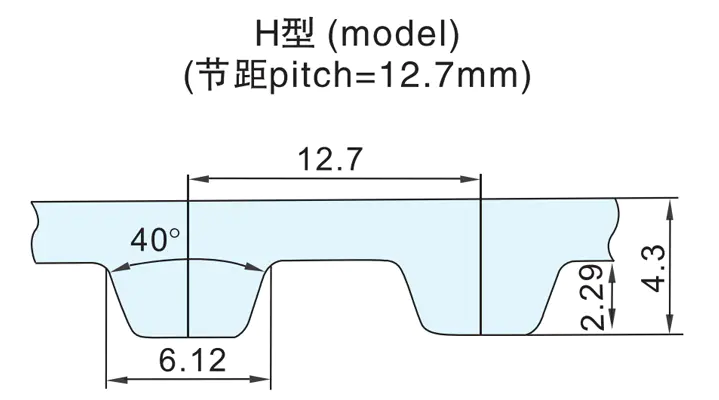
|
Size |
Pitch length |
Teeth Number |
Size |
Pitch length |
Teeth Number |
Size |
Pitch length |
Teeth Number |
|
160H* |
406.40 |
32 |
480H* |
1219.20 |
96 |
985H* |
2501.90 |
197 |
|
185H* |
469.90 |
37 |
485H* |
1231.90 |
97 |
1120H* |
2844.80 |
224 |
|
200H* |
508.00 |
40 |
490H* |
1244.60 |
98 |
1140H* |
2895.60 |
228 |
|
205H* |
520.70 |
41 |
500H* |
1270.00 |
100 |
1150H* |
2921.00 |
230 |
|
210H* |
533.40 |
42 |
510H* |
1295.40 |
102 |
1160H* |
2946.40 |
232 |
|
215H* |
546.10 |
43 |
515H* |
1308.10 |
103 |
1170H* |
2971.80 |
234 |
|
220H* |
558.80 |
44 |
520H* |
1320.80 |
104 |
1175H* |
2984.50 |
235 |
|
225H* |
571.50 |
45 |
525H* |
1333.50 |
105 |
1180H* |
2997.20 |
236 |
|
230H* |
584.20 |
46 |
530H* |
1346.20 |
106 |
1200H* |
3048.00 |
240 |
|
235H* |
596.90 |
48 |
535H |
1358.90 |
107 |
1250H* |
3175.00 |
250 |
|
240H* |
609.60 |
48 |
540H* |
1371.60 |
108 |
1285H* |
3263.90 |
257 |
|
245H* |
622.30 |
49 |
545H |
1384.30 |
109 |
1300H* |
3302.00 |
260 |
|
250H* |
635.00 |
50 |
550H* |
1397.00 |
110 |
1325H* |
3365.50 |
265 |
|
255H* |
647.70 |
51 |
555H |
1409.70 |
111 |
1350H* |
3429.00 |
270 |
|
260H* |
660.40 |
52 |
560H* |
1422.40 |
112 |
1360H* |
3454.40 |
272 |
|
265H* |
673.10 |
53 |
570H* |
1447.80 |
114 |
1375H* |
3492.50 |
275 |
|
270H* |
685.80 |
54 |
575H |
1460.50 |
115 |
1390H* |
3530.60 |
278 |
|
275H* |
698.50 |
55 |
580H* |
1473.20 |
116 |
1400H* |
3556.00 |
280 |
|
280H* |
711.20 |
56 |
585H* |
1485.90 |
117 |
1420H |
3606.80 |
284 |
|
285H* |
723.90 |
57 |
590H* |
1498.60 |
118 |
1430H |
3632.20 |
286 |
|
290H* |
736.60 |
58 |
600H* |
1524.00 |
120 |
1440H |
3657.60 |
288 |
|
300H* |
762.00 |
60 |
605H* |
1536.70 |
121 |
1445H |
3670.30 |
289 |
|
305H* |
774.70 |
61 |
610H* |
1549.40 |
122 |
1450H* |
3683.00 |
290 |
|
310H* |
787.40 |
62 |
615H* |
1562.10 |
123 |
1460H |
3708.40 |
292 |
|
315H* |
800.10 |
63 |
625H* |
1587.50 |
125 |
1490H |
3784.60 |
298 |
|
320H* |
812.80 |
64 |
630H* |
1600.20 |
126 |
1510H |
3835.40 |
302 |
|
330H* |
838.20 |
66 |
640H* |
1625.60 |
128 |
1520H |
3860.80 |
304 |
|
335H* |
850.90 |
67 |
645H* |
1638.30 |
129 |
1535H |
3898.90 |
307 |
|
340H* |
863.60 |
68 |
650H* |
1651.00 |
130 |
1540H* |
3911.60 |
308 |
|
345H* |
876.30 |
69 |
660H* |
1676.40 |
132 |
1560H |
3962.40 |
312 |
|
350H* |
889.00 |
70 |
670H* |
1701.80 |
134 |
1595H |
4051.30 |
319 |
|
355H* |
901.70 |
71 |
680H* |
1727.20 |
136 |
1600H* |
4064.00 |
320 |
|
360H* |
914.40 |
72 |
700H* |
1778.00 |
140 |
1630H* |
4140.20 |
326 |
|
365H* |
927.10 |
73 |
710H* |
1803.40 |
142 |
1645H |
4178.30 |
329 |
|
370H* |
939.80 |
74 |
720H* |
1828.80 |
144 |
1650H |
4191.00 |
330 |
|
375H* |
952.50 |
75 |
725H* |
1841.50 |
145 |
1680H* |
4267.20 |
336 |
|
380H* |
965.20 |
76 |
730H* |
1854.20 |
146 |
1700H* |
4318.00 |
340 |
|
385H* |
977.90 |
77 |
740H* |
1879.60 |
148 |
1750H |
4445.00 |
350 |
|
390H* |
990.60 |
78 |
750H* |
1905.00 |
150 |
1790H |
4546.60 |
358 |
|
395H* |
1003.30 |
79 |
770H* |
1955.80 |
154 |
1800H* |
4572.00 |
360 |
|
400H* |
1016.00 |
80 |
780H* |
1981.20 |
156 |
1830H |
4648.20 |
366 |
|
405H* |
1028.70 |
81 |
785H* |
1993.90 |
157 |
1850H |
4699.00 |
370 |
|
410H* |
1041.40 |
82 |
800H* |
2032.00 |
160 |
1900H |
4826.00 |
380 |
|
415H* |
1054.10 |
83 |
810H* |
2057.40 |
162 |
1950H |
4953.00 |
390 |
|
420H* |
1066.80 |
84 |
820H* |
2082.80 |
164 |
2000H* |
5080.00 |
400 |
|
425H* |
1079.50 |
85 |
830H* |
2108.20 |
166 |
2005H |
5092.70 |
401 |
|
430H* |
1092.20 |
86 |
840H* |
2133.60 |
168 |
2010H* |
5105.40 |
402 |
|
440H* |
1117.60 |
88 |
850H* |
2159.00 |
170 |
2050H |
5207.00 |
410 |
|
445H* |
1130.30 |
89 |
860H* |
2184.40 |
172 |
2100H |
5334.00 |
420 |
|
450H* |
1143.00 |
90 |
880H* |
2235.20 |
176 |
2125H |
5397.50 |
425 |
|
455H* |
1155.70 |
91 |
900H* |
2286.00 |
180 |
2150H |
5461.00 |
430 |
|
460H* |
1168.40 |
92 |
950H* |
2413.00 |
190 |
2180H |
5537.20 |
436 |
|
465H* |
1181.10 |
93 |
960H* |
2438.40 |
192 |
2200H |
5588.00 |
440 |
|
470H* |
1193.80 |
94 |
980H* |
2489.20 |
196 |
|
|
|
In stallation size is available if need.

|
Size |
Pitch length |
Teeth Number |
Size |
Pitch length |
Teeth Number |
Size |
Pitch length |
Teeth Number |
|
341XH |
866.78 |
39 |
621XH |
1577.98 |
71 |
840XH* |
2133.60 |
96 |
|
368XH |
933.45 |
42 |
630XH* |
1600.20 |
72 |
927XH* |
2355.85 |
106 |
|
394XH |
1000.13 |
45 |
648XH |
1644.65 |
74 |
980XH* |
2489.20 |
112 |
|
411XH |
1044.58 |
47 |
656XH |
1666.88 |
75 |
1120XH* |
2844.80 |
128 |
|
420XH* |
1066.80 |
48 |
665XH |
1689.10 |
76 |
1260XH* |
3200.40 |
144 |
|
429XH |
1089.03 |
49 |
691XH |
1755.78 |
79 |
1330XH |
3378.20 |
152 |
|
446XH |
1133.48 |
51 |
700XH* |
1778.00 |
80 |
1400XH* |
3556.00 |
160 |
|
481XH |
1222.38 |
55 |
709XH |
1800.23 |
81 |
1540XH |
3911.60 |
176 |
|
499XH |
1266.83 |
57 |
726XH* |
1844.68 |
83 |
1619XH |
4111.63 |
185 |
|
507XH* |
1289.05 |
58 |
726.5XH* |
1844.68 |
83 |
1750XH* |
4445.00 |
200 |
|
543XH |
1377.95 |
62 |
735XH* |
1866.90 |
84 |
1838XH |
4667.25 |
210 |
|
560XH* |
1422.40 |
64 |
753XH* |
1911.35 |
86 |
1925XH |
4889.50 |
220 |
|
569XH |
1444.63 |
65 |
752.5XH* |
1911.35 |
86 |
2030XH |
5156.20 |
232 |
|
570XH* |
1444.63 |
65 |
753XH* |
1911.35 |
86 |
2100XH |
5334.00 |
240 |
|
595XH |
1511.30 |
68 |
761 XH* |
1933.58 |
87 |
2196XH |
5578.48 |
251 |
|
604XH |
1533.53 |
69 |
770XH* |
1955.80 |
88 |
|
|
|
|
613XH |
1555.75 |
70 |
796XH* |
2022.48 |
91 |
|
|
|
In stallation size is available if need.

|
Size |
Pitch length |
Teeth Number |
Size |
Pitch length |
Teeth Number |
Size |
Pitch length |
Teeth Number |
|
T2.5-100 |
100.00 |
40 |
T2.5-245* |
245.00 |
98 |
T2.5-1400 |
1400.00 |
560 |
|
T2.5-120 |
120.00 |
48 |
T2.5-265* |
265.00 |
106 |
T2.5-1475 |
1475.00 |
590 |
|
T2.5-125 |
125.00 |
50 |
T2.5-290* |
290.00 |
116 |
T2.5-1500 |
1500.00 |
600 |
|
T2.5-135 |
135.00 |
54 |
T2.5-330* |
330.00 |
132 |
T2.5-1600 |
1600.00 |
640 |
|
T2.5-145* |
145.00 |
58 |
T2.5-350* |
350.00 |
140 |
T2.5-1800 |
1800.00 |
720 |
|
T2.5-150* |
150.00 |
60 |
T2.5-380* |
380.00 |
152 |
T2.5-2000 |
2000.00 |
800 |
|
T2.5-155* |
155.00 |
62 |
T2.5-400 |
400.00 |
160 |
T2.5-2100 |
2100.00 |
840 |
|
T2.5-157.5* |
157.50 |
63 |
T2.5-425 |
425.00 |
170 |
T2.5-2200 |
2200.00 |
880 |
|
T2.5-158* |
158.00 |
63 |
T2.5-550 |
550.00 |
220 |
T2.5-2500 |
2500.00 |
1000 |
|
T2.5-160* |
160.00 |
64 |
T2.5-580 |
580.00 |
232 |
T2.5-2825 |
2825.00 |
1130 |
|
T2.5-162.5* |
162.50 |
65 |
T2.5-650* |
650.00 |
260 |
T2.5-3000 |
3000.00 |
1200 |
|
T2.5-172.5* |
172.50 |
69 |
T2.5-800 |
800.00 |
320 |
T2.5-3250 |
3250.00 |
1300 |
|
T2.5-177.5* |
177.50 |
71 |
T2.5-830* |
830.00 |
332 |
T2.5-3550 |
3550.00 |
1420 |
|
T2.5-178* |
177.50 |
71 |
T2.5-950 |
950.00 |
380 |
T2.5-3900 |
3900.00 |
1560 |
|
T2.5-185* |
185.00 |
74 |
T2.5-1000 |
1000.00 |
400 |
T2.5-4250 |
4250.00 |
1700 |
|
T2.5-195* |
195.00 |
78 |
T2.5-1070* |
1070.00 |
428 |
T2.5-4500 |
4500.00 |
1800 |
|
T2.5-217.5* |
217.50 |
87 |
T2.5-1100 |
1100.00 |
440 |
T2.5-4750 |
4750.00 |
1900 |
|
T2.5-225* |
225.00 |
90 |
T2.5-1250 |
1250.00 |
500 |
T2.5-5000 |
5000.00 |
2000 |
|
T2.5-230* |
230.00 |
92 |
T2.5-1325 |
1325.00 |
530 |
T2.5-5600 |
5600.00 |
2240 |
In stallation size is available if need.
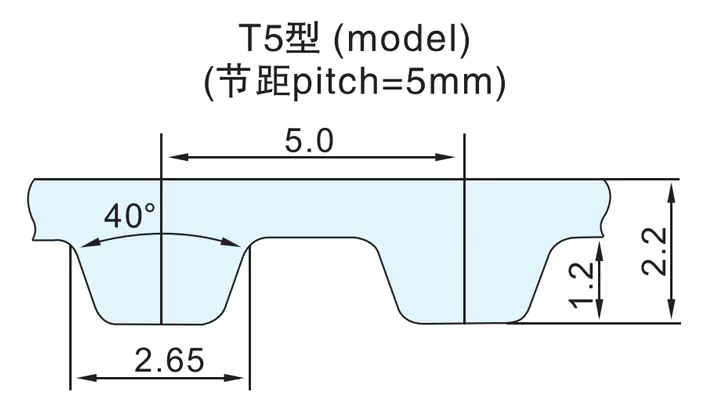
|
Size |
Pitch length |
Teeth Number |
Size |
Pitch length |
Teeth Number |
Size |
Pitch length |
Teeth Number |
|
T5-185* |
185.00 |
37 |
T5-460* |
460.00 |
92 |
T5-1150* |
1150.00 |
230 |
|
T5-190* |
190.00 |
38 |
T5-475* |
475.00 |
95 |
T5-1215* |
1215.00 |
243 |
|
T5-200* |
200.00 |
40 |
T5-490* |
490.00 |
98 |
T5-1380* |
1380.00 |
276 |
|
T5-210* |
210.00 |
42 |
T5-500* |
500.00 |
100 |
T5-1430 |
1430.00 |
286 |
|
T5-215* |
215.00 |
43 |
T5-510* |
510.00 |
102 |
T5-1600 |
1600.00 |
320 |
|
T5-240* |
240.00 |
48 |
T5-525* |
525.00 |
105 |
T5-1800 |
1800.00 |
360 |
|
T5-245* |
245.00 |
49 |
T5-550* |
550.00 |
110 |
T5-2200 |
2200.00 |
440 |
|
T5-250* |
250.00 |
50 |
T5-560* |
560.00 |
112 |
T5-2280* |
2280.00 |
456 |
|
T5-255* |
255.00 |
51 |
T5-610* |
610.00 |
122 |
T5-2400 |
2400.00 |
480 |
|
T5-270* |
270.00 |
54 |
T5-660* |
660.00 |
132 |
T5-2800 |
2800.00 |
560 |
|
T5-275* |
275.00 |
55 |
T5-725* |
725.00 |
145 |
T5-3100 |
3100.00 |
620 |
|
T5-280* |
280.00 |
56 |
T5-750* |
750.00 |
150 |
T5-3300 |
3300.00 |
660 |
|
T5-300* |
300.00 |
60 |
T5-780* |
780.00 |
156 |
T5-3500 |
3500.00 |
700 |
|
T5-355* |
355.00 |
71 |
T5-810* |
810.00 |
162 |
T5-3700 |
3700.00 |
740 |
|
T5-390* |
390.00 |
78 |
T5-840* |
840.00 |
168 |
T5-4000 |
4000.00 |
800 |
|
T5-410* |
410.00 |
82 |
T5-900* |
900.00 |
180 |
T5-4200 |
4200.00 |
840 |
|
T5-420* |
420.00 |
84 |
T5-920 |
920.00 |
184 |
T5-4600 |
4600.00 |
920 |
|
T5-425 |
425.00 |
85 |
T5-975 |
975.00 |
195 |
T5-4800 |
4800.00 |
960 |
|
T5-430 |
430.00 |
86 |
T5-990* |
990.00 |
198 |
T5-5000 |
5000.00 |
1000 |
|
T5-445* |
445.00 |
89 |
T5-1045* |
1045.00 |
209 |
T5-5600 |
5600.00 |
1120 |
|
T5-450* |
450.00 |
90 |
T5-1075* |
1075.00 |
215 |
|
|
|
|
T5-455* |
455.00 |
91 |
T5-1100* |
1100.00 |
220 |
|
|
|
In stallation size is available if need.

|
Size |
Pitch length |
Teeth Number |
Size |
Pitch length |
Teeth Number |
Size |
Pitch length |
Teeth Number |
|
T10-260 |
260.00 |
26 |
T10-1100* |
1100.00 |
110 |
T10-3200 |
3200.00 |
320 |
|
T10-360* |
360.00 |
60 |
T10-1110* |
1110.00 |
111 |
T10-3450 |
3450.00 |
345 |
|
T10-370 |
370.00 |
37 |
T10-1150* |
1150.00 |
115 |
T10-3560 |
3560.00 |
356 |
|
T10-380* |
380.00 |
38 |
T10-1210* |
1210.00 |
121 |
T10-3780 |
3780.00 |
378 |
|
T10-400 |
400.00 |
40 |
T10-1280* |
1280.00 |
128 |
T10-3900 |
3900.00 |
390 |
|
T10-440* |
440.00 |
44 |
T10-1300* |
1300.00 |
130 |
T10-4300 |
4300.00 |
430 |
|
T10-450 |
450.00 |
45 |
T10-1320* |
1320.00 |
132 |
T10-4390 |
4390.00 |
439 |
|
T10-480* |
480.00 |
48 |
T10-1350* |
1350.00 |
135 |
T10-4400 |
4400.00 |
440 |
|
T10-490* |
490.00 |
49 |
T10-1390* |
1390.00 |
139 |
T10-4580 |
4580.00 |
458 |
|
T10-500* |
500.00 |
50 |
T10-1420* |
1420.00 |
142 |
T10-4660 |
4660.00 |
466 |
|
T10-510* |
510.00 |
51 |
T10-1460* |
1460.00 |
146 |
T10-4720 |
4720.00 |
472 |
|
T10-530* |
530.00 |
53 |
T10-1490* |
1490.00 |
149 |
T10-4800 |
4800.00 |
480 |
|
T10-540 |
540.00 |
54 |
T10-1540* |
1540.00 |
154 |
T10-4850 |
4850.00 |
485 |
|
T10-550 |
550.00 |
55 |
T10-1560* |
1560.00 |
156 |
T10-4920 |
4920.00 |
492 |
|
T10-560* |
560.00 |
56 |
T10-1610* |
1610.00 |
161 |
T10-4960 |
4960.00 |
496 |
|
T10-580 |
580.00 |
58 |
T10-1630* |
1630.00 |
163 |
T10-4980 |
4980.00 |
498 |
|
T10-600* |
600.00 |
60 |
T10-1750* |
1750.00 |
175 |
T10-5000 |
5000.00 |
500 |
|
T10-630* |
630.00 |
63 |
T10-1780* |
1780.00 |
178 |
T10-5060 |
5060.00 |
506 |
|
T10-660* |
660.00 |
66 |
T10-1800* |
1800.00 |
180 |
T10-5100 |
5100.00 |
510 |
|
T10-700* |
700.00 |
70 |
T10-1880* |
1880.00 |
188 |
T10-5180 |
5180.00 |
518 |
|
T10-720* |
720.00 |
72 |
T10-1960* |
1960.00 |
196 |
T10-5200 |
5200.00 |
520 |
|
T10-730* |
730.00 |
73 |
T10-2120 |
2120.00 |
212 |
T10-5220 |
5220.00 |
522 |
|
T10-780* |
780.00 |
78 |
T10-2250* |
2250.00 |
225 |
T10-5240 |
5240.00 |
524 |
|
T10-810* |
810.00 |
81 |
T10-2580 |
2500.00 |
250 |
T10-5310 |
5310.00 |
531 |
|
T10-840* |
840.00 |
84 |
T10-2500 |
2580.00 |
258 |
T10-5350 |
5350.00 |
535 |
|
T10-910* |
910.00 |
91 |
T10-2670 |
2670.00 |
267 |
T10-5390 |
5390.00 |
539 |
|
T10-920* |
920.00 |
92 |
T10-2780 |
2780.00 |
278 |
T10-5400 |
5400.00 |
540 |
|
T10-980* |
980.00 |
98 |
T10-2850 |
2850.00 |
285 |
T10-5500 |
5500.00 |
550 |
|
T10-1000* |
1000.00 |
100 |
T10-2940 |
2940.00 |
294 |
T10-5550 |
5550.00 |
555 |
|
T10-1010* |
1010.00 |
101 |
T10-2990 |
2990.00 |
299 |
T10-5600 |
5600.00 |
560 |
|
T10-1080* |
1080.00 |
108 |
T10-3010 |
3010.00 |
301 |
|
|
|
In stallation size is available if need.

| Size | Pitch length | Teeth Number |
| 700XXH* | 1778.00 | 56 |
| 800XXH* | 2032.00 | 65 |
| 900XXH* | 2286.00 | 72 |
| 950XXH* | 2413.00 | 76 |
| 1000XXH* | 2540.00 | 80 |
| 1063XXH | 2698.75 | 85 |
| 1200XXH* | 3048.00 | 96 |
| 1400XXH* | 3556.00 | 112 |
| 1600XXH | 3968.75 | 128 |
| 1700XXH | 4318.00 | 136 |
| 1800XXH | 4572.00 | 144 |
In stallation size is available if need.

